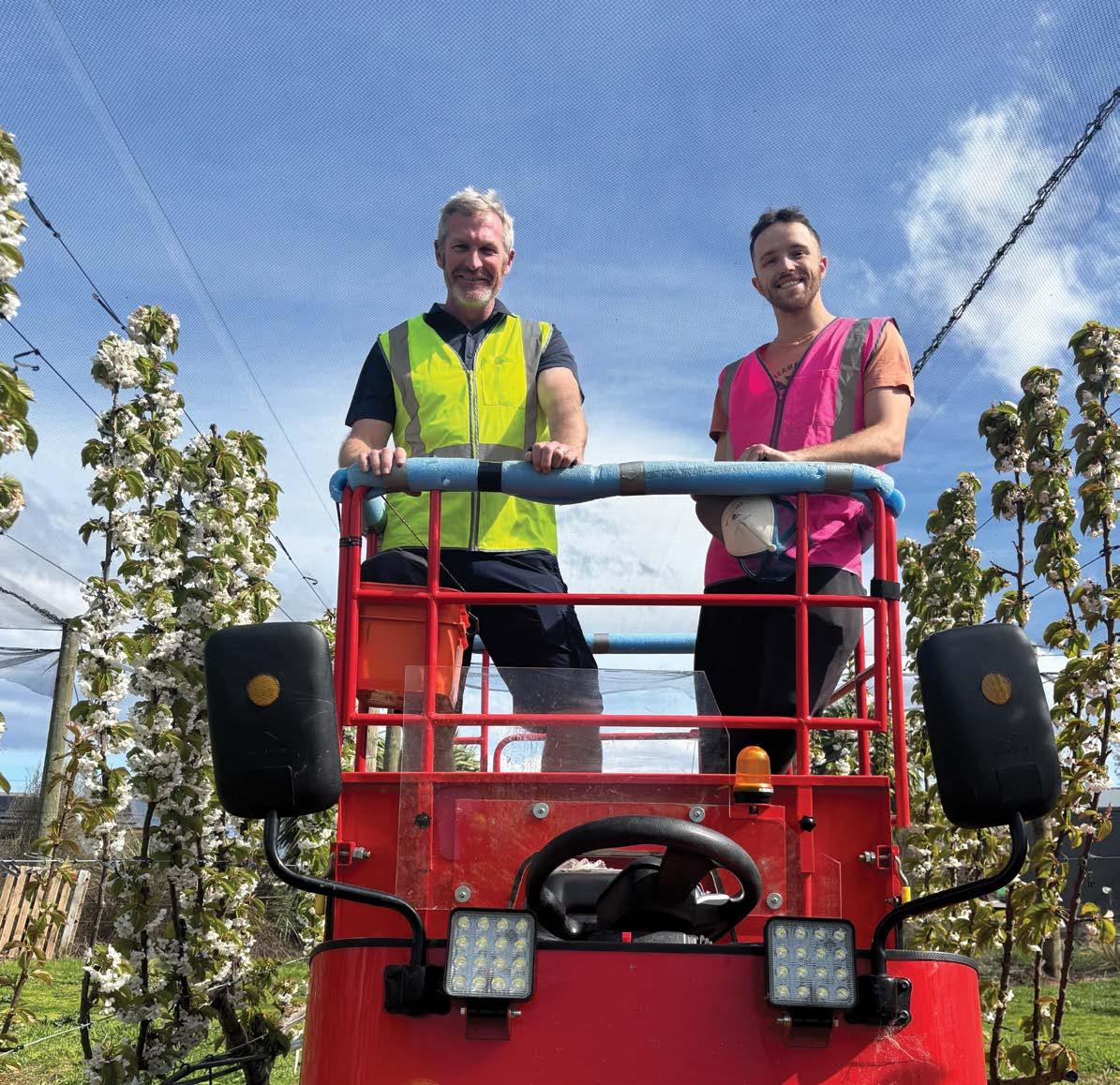

Rapid pest control. Better fruit!
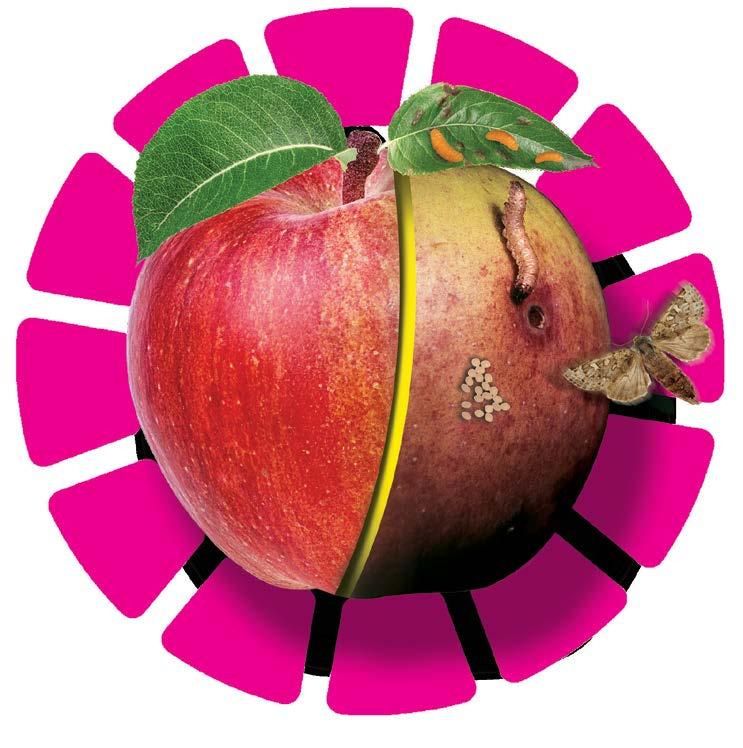
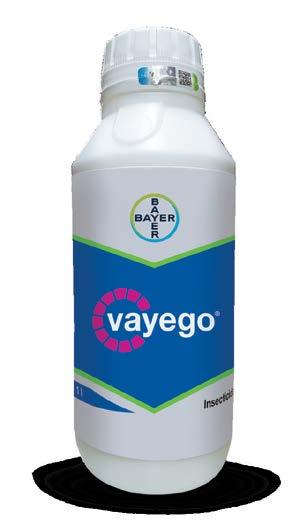
Unique, fast acting and systemic control of codling moth, leaf roller caterpiller and bronze beetle in pipfruit.
• New chemistry with a unique spectrum of pest control
• Strong proven activity against all life stages of moths
• Fast cessation of feeding with systemic activity and excellent length of activity
• Soft on key beneficials
Insist on Vayego from Bayer today!

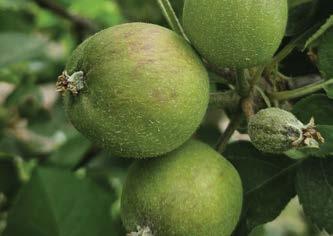
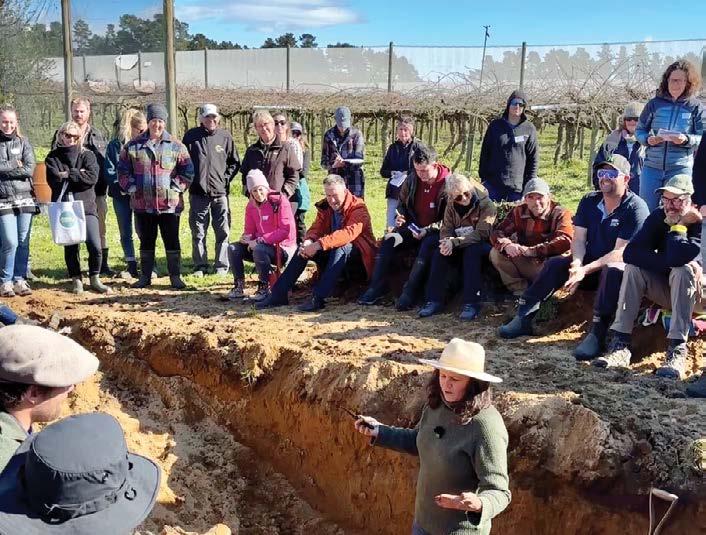

Innovation and know-how
Seeking productivity
34 Balancing the equation: how the SVS tool helps growers optimise nitrogen
38 What the hell is regenerative agriculture anyway?
42 Scholarship makes a real difference
Croploading – optimising carbohydrates to maximise crop potential
Industry good
61 TomatoesNZ update
64 Wind adds to challenging season
66 Top quality seed potato
69 HortNZ Weekly Briefing
What’s New
A regular advertorial section of new products and services. This publication does not endorse the products or services featured here.
16 Book Review: ‘Where have all the apples gone?’
On the cover:
Capital from overseas
New Zealand onion delegation strengthens ties with Indonesia
Common ground – reflections from
45 Maximising crop resilience: the MEGAFOL™ advantage
68 Improve fruit quality and harvest flexibility
Electric Cherries’ Euan White with orchard technician Mahe Pivert, of France. See page 12. Photo by Aimee Wilson.
Andrew Barber
Andrew has been involved in agricultural engineering consultancy and complex multi-stakeholder projects for over 20 years. He is managing director at Agrilink and project manager for the Sustainable Vegetable Systems (SVS) Tool. Read the update on the SVS Tool on page 34.
Meg Becker
Meg is an AgFirst consultant with a passion for grower consultancy in precision systems, identifying and overcoming block challenges, and working with greenfield developments to optimise orchards from the ground up. In this issue she discusses croploading on page 46.
Tim Cadogan
Tim is engagement specialist at the Water Services Authority – Taumata Arowai. Prior to that, he was Mayor of the Central Otago District where he worked closely with the horticulture sector. For this issue he contributed an update on drinking water on page 26.
Carly Gibbs
Carly has a background in community and national newspaper journalism. Carly lives in Te Puke, with her husband and two sons, on a kiwifruit orchard. For this issue she spoke with retired strawberry grower Margaret Dekker on page 20 and visited Baygold’s wetland project on page 23.
Jack Hughes
Jack is a consultant at Fruition, focusing on management of crop and canopy for maximum performance and profitability. He has an extensive background in commercial horticulture, research and consultancy. In this issue he discusses productivity and introduces Tagga on page 30.
CONTENTS
CONTRIBUTORS





Kenny Lau
Kenny is investment manager at the recently created government agency InvestNZ. Kenny previously looked after Asian investor markets in his role as an international investment manager based in Hong Kong. He shares his thoughts about attracting overseas investors to horticulture on page 52.
Diana Mathers
Diana has spent her whole career working with growers and farmers: Research and procurement for Wattie’s, project advisor for MAF’s Sustainable Farm and latterly as research manager for the environment at the Foundation for Arable Research (FAR). Read her article on regenerative growing on page 38.
Helena O’Neill
Helena is a journalist with a background in community and rural reporting. She lives in North Waikato with her husband, four children, and their Irish wolfhound. For this issue she went along to the Dominion Federation of New Zealand Chinese Commercial Growers annual conference dinner. See page 8.
Daniel Sutton
Originally from carrot growing country near Ohakune and now based in Pukekohe, Daniel is widely known by vegetable, onion and potato growers up and down the country through his roles in research and development extension and IPM. He contributes for this issue on the SVS Tool on page 34.
Aimee Wilson
Aimee Wilson is based in Alexandra and covers horticulture in Central Otago where she grew up. She still can’t believe how many different varieties of fruit there is, compared to back in the 1980s – when it was mostly just Dawson and Moorpark. For this issue she visited Mike Casey and Euan White in Cromwell on page 12.





INDUSTRY LEADERSHIP REGULARS
4 Bernadine Guilleux, HortNZ chair
6 Kate Scott, HortNZ chief executive
54 Kazi Talaska, Onions New Zealand general manager
58 Karen Morrish, NZ Apples & Pears chief executive
61 Dinah Cohen, TomatoesNZ general manager
64 Brad Siebert, NZ Avocado chief executive
66 Kate Trufitt, Potatoes New Zealand chief executive
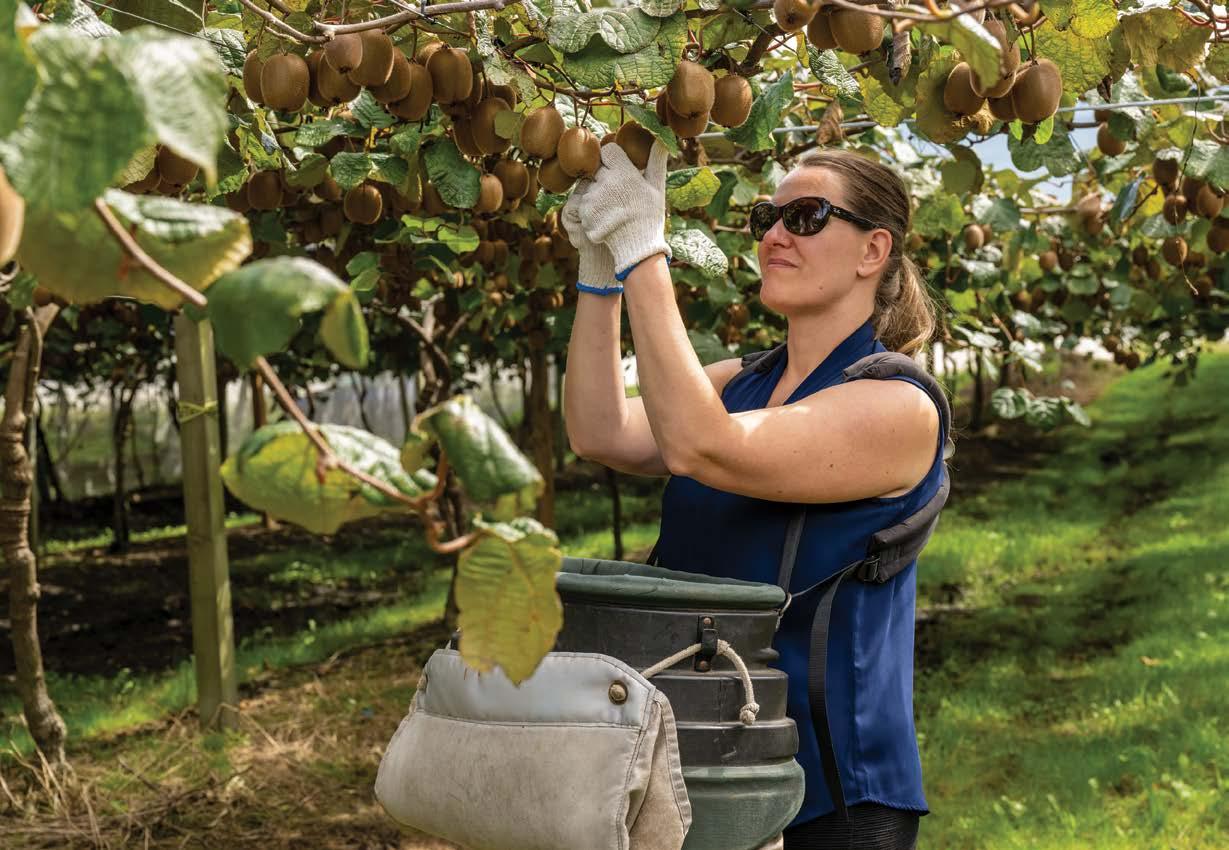
Horticulture Work-based Training
Do you or your team members want to develop new skills and knowledge in horticulture? Get in touch with Primary ITO today to find out more about training options for you and your business.
• Certificates and Apprenticeships
• Support and Funding Available
• Specialist training programmes in Fruit, Indoor and Outdoor Crop Production, Nursery, Post-Harvest and Distribution.
Talk to your local Training Adviser today: primaryito.ac.nz | 0800 20 80 20 | info@primaryito.ac.nz *Terms and conditions apply.

NZGrower & Orchardist is produced by Horticulture New Zealand and is free for all levy payers. The magazine is partially funded by a grant from the NZ Fruitgrowers’ Charitable Trust to ensure all fruit growers in New Zealand receive a copy each month. The magazine is also supported by Vegetables NZ, Process Vegetables NZ, TomatoesNZ, Potatoes NZ and Onions NZ.
The individual comments and views in this magazine do not necessarily represent the view of Horticulture New Zealand.
ELECTION YEAR APPROACHES
Determining clear, consistent policy positions is core to the work we do – and this is a key priority as we look ahead to an election year.
Bernadine Guilleux: HortNZ chair
Copyright © 2025 NZGrower & Orchardist
NZGrower & Orchardist:
ISSN: 3021-3606 (Print)
ISSN: 3021-3614 (Online)
Editor: John Gauldie, editor@hortnz.co.nz
Advertising Manager: Debbie Pascoe, 027 485 8562, debbie.pascoe@hortnz.co.nz
Design: Scenario.co.nz, 04 385 9766, joy@scenario.co.nz
Subscriptions: subs@hortnz.co.nz, 04 472 3795
With New Zealanders set to head to the polls in 2026, the HortNZ Board met late October to discuss the policies growers tell us are important to them.
It was timely to introduce our new directors, Simon Cook, Dermott Malley and Shaun Vickers, to HortNZ and their contribution to the discussions was appreciated by our existing directors. Playing to their complementary strengths, the directors had robust discussions on the future of fruit and vegetable growing in New Zealand –nutrition, climate adaptation, energy and infrastructure, and workforce.
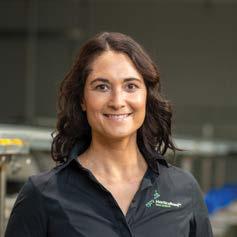
Every day, the media shows how global political trends, such as weakening democracies, growing regional divisions and declining trust in public institutions, are affecting New Zealand.
This publication uses vegetable-based inks and environmentally responsible paper produced from Forest Stewardship Council® (FSC®) certified, Mixed Source pulp from Responsible Sources.
Paper produced using Elemental Chlorine Free (ECF) and manufactured under the strict ISO14001 Environmental Management System.
The wrapper we use is 100 percent recyclable, it is LDPE 4 (Low Density Polyethylene) Soft Plastic and meets the required standards. For further information refer to: www.recycling.kiwi.nz/our-story
These are big, intergenerational issues that affect every business and community – we are focused on how growers today are enabled to chart the course ahead for growers of tomorrow.
That’s why our role in New Zealand politics needs to be more strategic than ever: to focus on the core contributions our industry makes that appeal across all political parties. Over the coming months, we will be sharing our priorities with current Ministers, MPs and officials, as well as all potential and future Ministers and MPs. We’ll be working hard to ensure our priorities are front of mind for politicians as they shape their policies ahead of the election. This will enable us to have the best chance of achieving outcomes that benefit growers and the wider horticulture sector.
EVERY DAY, THE MEDIA SHOWS HOW GLOBAL POLITICAL TRENDS, SUCH AS WEAKENING DEMOCRACIES, GROWING REGIONAL DIVISIONS AND DECLINING TRUST IN PUBLIC INSTITUTIONS , ARE AFFECTING NEW ZEALAND
ALFRED
A FIRM FAVOURITE –THE TOMATO YOU CAN TRUSST
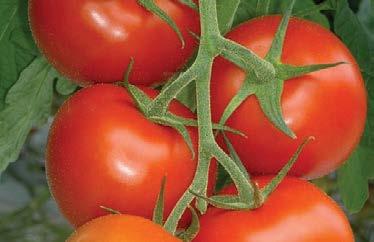
HR: ToMV/Ff:A-E/Fol:0,1/For/Va/ Vd/Ma/Mi/Mj
• Vigorous plant suitable for short or long crops
• Compact habit particularly suitable for low wire greenhouses
• High yielding variety with top quality fruit
• Produces large fruit with afw 120-140g
• Fruit has excellent taste and long keeping qualities
• Extensive disease resistances including leaf mould
• Heat and cold tolerant
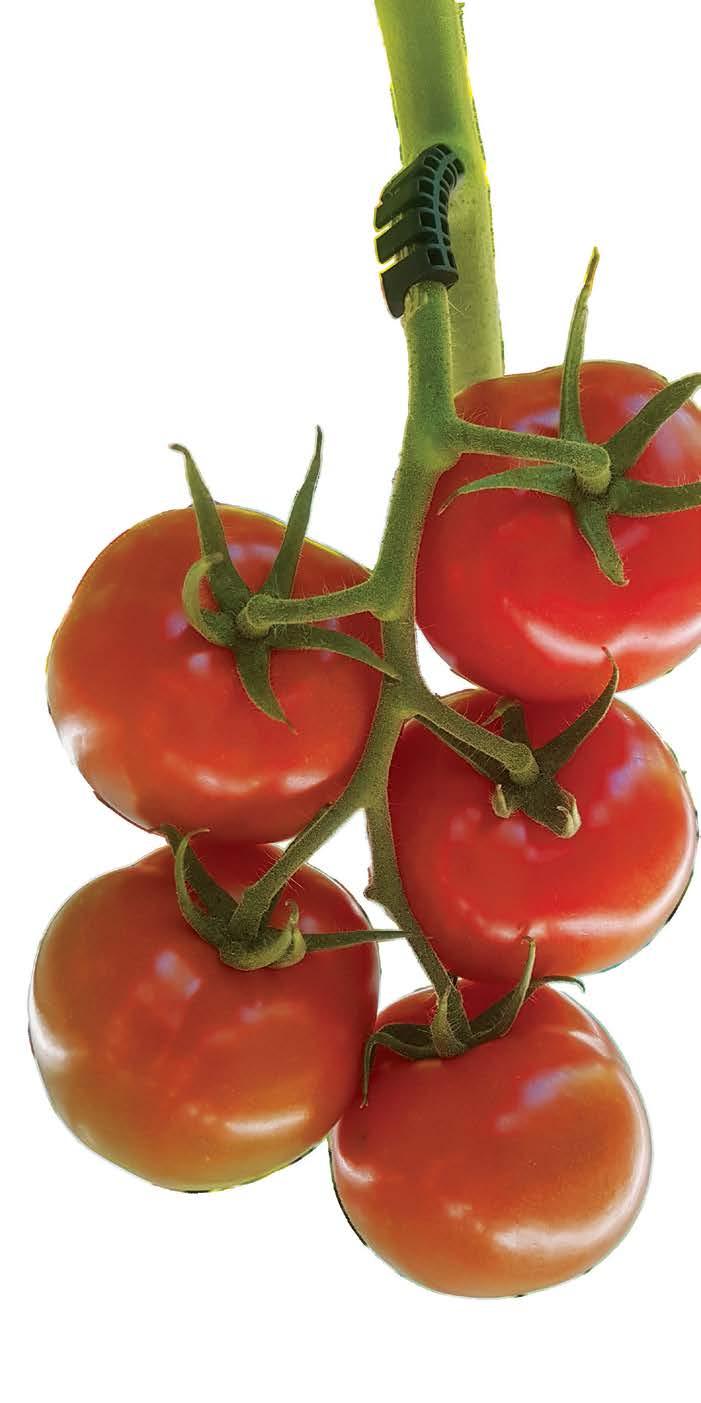
CONTACT
Imke Blackett
Greenhouse Crops and Northern region 027 2444 611
Imke.blackett@premierseeds.co.nz
Benjamin Carrell South Island 027 2444 651
Benjamin.carrell@premierseeds.co.nz
www.premierseeds.co.nz
WORKING TOWARDS THE SAME BIGGER PICTURE
One of the things I love most about New Zealand horticulture is its diversity. Across the country, growers are producing an incredible range of fruit and vegetables, from apples and avocados to onions, berries, kiwifruit and leafy greens.
Kate Scott : HortNZ chief executive
That diversity gives our industry strength and resilience. But it also means we have a lot of different voices, and sometimes it can be hard to get everyone heading in the same direction.
That’s why I’m really pleased to see the launch of a new pilot project called The Common Ground initiative, funded by AGMARDT.
The idea is really simple – to look at how we can work better together across horticulture, around shared priorities and long-term goals. In the end, it’s about delivering more value for growers and building a stronger, more connected industry.
The pilot builds on the Aotearoa Horticulture Action Plan (AHAP), which sets out a shared pan-sector vision for the future of horticulture.
It recognises that while our product groups, businesses and regional organisations are each doing great things, we can achieve even more when we come together as a united voice and collaborate.
Whether that’s in advocacy, research, workforce development or environmental management, working together helps ensure every grower’s levy dollar goes further.
It’s a chance to take a step back and ask, how can we make horticulture greater than the sum of its parts? How can we make sure our efforts, across different crops and regions, are adding up to real progress for growers?
I’m looking
forward to working with the partners involved in the pilot and hearing from growers along the way

For me, this pilot is about ensuring we’re all working towards the same bigger picture: helping New Zealand horticulture thrive and remain a strong, competitive land use for the long term.
That means focusing on the things that matter most to growers – from water storage and workforce to climate resilience and biosecurity. It also means reducing duplication and making sure resources are spent where they have the most impact.
Of course, collaboration doesn’t just happen. It takes trust, structure and a clear sense of shared purpose. The Common Ground pilot will test practical ways of creating that – exploring better ways for our industry organisations and product groups to continue working together to align more closely and continue to support growers.
We’ve set ourselves an ambitious goal as a sector: to double horticulture’s farmgate value by 2035. To get there, we’ll need to be more joined-up and strategic than ever before. The Common Ground initiative is an important step in that direction, as we work in a world where collaboration is no longer optional, it’s essential.
I’m looking forward to working with the partners involved in the pilot and hearing from growers along the way.
WHETHER THAT’S IN ADVOCACY, RESEARCH, WORKFORCE DEVELOPMENT OR ENVIRONMENTAL MANAGEMENT, WORKING TOGETHER HELPS ENSURE EVERY GROWER’S LEVY DOLLAR GOES FURTHER
I am confident we can build stronger connections, support each other through the challenges and create more opportunities for growth.
Of course, collaboration doesn’t just happen. It takes trust, structure and a clear sense of shared purpose
Because at the end of the day, we all want the same thing – a thriving, sustainable horticulture sector that’s good for growers, good for our communities and good for New Zealand.
We’re ready to go and gearing up for a busy budding season. Get in touch with our sales team to secure your future trees.


CELEBRATING A RICH GROWING HISTORY
The Dominion Federation of NZ Chinese Commercial Growers recently held its 83rd annual conference dinner in Auckland, a popular event in the horticulture calendar.
Helena O’Neill
Growers, former growers, suppliers, market representatives and others from the horticulture sector come together to celebrate ChineseNew Zealand growers and to strengthen working relationships.
This year, National Party list MP Nancy Lu spoke at the dinner on behalf of Prime Minister Christopher Luxon.
“I want to acknowledge the great work that you do as an association for all the Chinese growers and all of the stakeholders in the sector in New Zealand.
“I also want to recognise Ruth [Lam], particularly because she is at my table, but also because I’ve actually read your work. For me, as a Chinese New Zealander, to understand the history of the many Chinese growers and market
gardeners before me and the incredible work that they do to represent Chinese in New Zealand.
“These remarkable histories reflect not only the longevity but also the unity and determination of generations of growers who have fed New Zealand families and strengthened our economy.”
She thanked past and present growers for their contributions to horticulture and the country.
“As we look forward to the future, let us honour the remarkable history as documented by amazing authors like Ruth, but also continue the support of our growers to keep New Zealand nourished, richer, and celebrating and sharing that story.”
From left: Jeffery Turner, who was awarded a Certificate of Advocacy, Kerry Young and Norman Young


The New Zealand Chinese Growers’ Association (later known as the Dominion Federation of NZ Chinese Commercial Growers) was formed in the 1940s. It was created as a central body to coordinate a co-operative and liaise with officials to supply vegetables for allied troops in the Pacific as part of the war effort. Its history is told in books, Sons of Soil by Lily Lee and Ruth Lam, and Success through Adversity by historian Nigel Murphy.
As chair of the Dominion Federation of NZ Chinese Commercial Growers, Dennis Fong advocates for best-growing practices, is involved in networking, and encourages growers to work together to secure better prices for services and supplies.
Dennis says the annual conference and dinner were the highlights for the federation.
The association awarded two Life Memberships at the dinner – to committee member Ginny Sue and grower Jackie Young.
Chair of Fresh Direct Ltd/J&P Turner Group, Jeffery Turner, was also awarded a Certificate of Advocacy in recognition of the long relationship he has had with growers and the association.
“It’s a special part of my life to have the long friendships with the community of Chinese growers who have been such a great support to not only our company, but the industry. You have made a huge impact on the industry, and I hope that continues for many years,” Jeffery said on accepting the award.
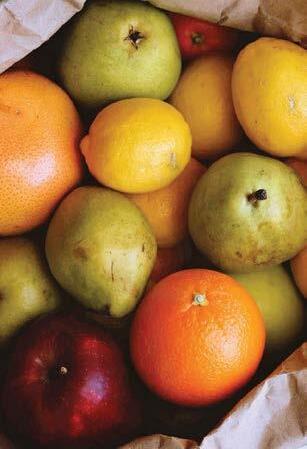

From left: Growers James Young, Tony Tse and Ken Gee
Jackie Young, who is still growing near Pukekohe, was presented with Life Membership at the conference dinner

Bobby Lowe works for his family market garden business at Runciman, south of Auckland, but also serves as secretary of the Dominion Federation of NZ Chinese Commercial Growers.
He says a Life Membership is given to volunteers who have contributed to the Dominion Federation for over 30 years.
“However, we have now adjusted it, as it’s pretty challenging to achieve 30 years of service.”
Speaking to NZGrower & Orchardist, Ginny Sue says it has been a great experience being on the committee.
“I never expected Life Membership as I’m not strictly a grower – my husband and his brothers are.
“The guys on the committee had to get used to me, just as I had to get used to them. When it came to taking notes, it was really quite hard. They would sometimes get distracted, and I would wonder if I needed to be taking notes. I was from a fruit shop family background… it was a big learning curve. As I took notes and listened to them, the English might not be perfect, but they are really smart. People who don’t know them don’t always realise how smart these growers are.”
Ginny highlights that many growers gave up other careers in China when they came out to New Zealand, turning to growing to support their families in a new country where they did not speak the language. Those growers’ children have now gone on to develop their
own careers, often outside of horticulture, rather than continuing the family business.
Ginny says committee members over the years have dedicated a lot of time to building and maintaining the Dominion Federation of NZ Chinese Commercial Growers.
“Howe Young, for example, has poured his heart and soul into the federation – he knows so much about the history too.”
I’ve seen a lot
of good progress with the federation over the years
Jackie Young, 76, is still growing onions, sweetcorn, carrots, cabbage and broccoli on 60 hectares (including leased land) at Puni, near Pukekohe.
At its peak, the business had three brothers growing vegetables, but one has since retired, leaving Jackie splitting the operation with his remaining grower-brother.
“I’ve seen a lot of good progress with the federation over the years, especially with technology and the fellowship of everyone working together with the markets and the retailers.”
While the federation is more of a social organisation now, Jackie says it was important to get together as growers and past growers to keep those connections alive.
From left: National MP Nancy Lu, new Life Membership recipient Ginny Sue, Dennis Fong and Mount Roskill MP Dr Carlos Cheung

LEADING THE POSITIVE CHARGE
Electrification in horticulture is surging ahead. Costs are falling and technology is improving. Euan White and Mike Casey, winners of the HortNZ Environment Award in 2023, were already blazing the trail years go. Today, they have not only electrified every aspect of their operation, they’re now electrifying the market with their Electric Cherries brand.
The cherry orchard at Forest Lodge north of Cromwell is buzzing.
Having recently rebranded to Electric Cherries, one could be mistaken in thinking there is some highly charged fruit happening onsite, but it’s just the bees working their magic amongst the blossoms in the height of spring.
Mike Casey and Euan White have been on an electrification mission for many years now –leaders in renewable energy, and in the horticulture industry there have been many firsts.
Aimee Wilson
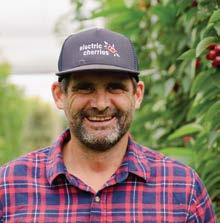
It has the capability to drive autonomously, removing not only the fuel costs, but the labour costs too.
It has gained a lot of interest nationally and 32 Members of Parliament have personally sat in it.
The pair are both good friends and business partners, along with their wives, and Euan is the orchard manager – he carries out all of the groundwork, while Mike has been busy co-founding the charity ‘Rewiring Aotearoa.’
The electric tractor, made by Monarch in California, is the first of its kind in the Southern Hemisphere.
Mike Casey with cherries.
Photo courtesy of Electric Cherries
The Californian Monarch electric tractor with its New Zealand-made sprayer has a spray runtime of 10 hours

Mike says solar should be available to everyone, and fortunately solar panels and battery technology are now starting to become more affordable.
“The technology is getting better and more people are making it,” he says, with costs having plummeted in recent years.
He says the more people rolling out solar (particularly farmers and growers), instead of using power straight from the national grid, the better – it would help lower the price for everyone.
“The payback is phenomenal if you use the cheap power that you make.”
Technology trailblazers
Electric Cherries also owns the country’s first electric sprayer – that attaches to the Monarch, and just recently they purchased the first electric work platform.


The Pickman PICCA elevated work platform and tipper is also self-driving with the use of a remote control, and the combination is …’revolutionary,’ according to Euan.
The team uses the super-powered vehicle to help prune the tops of their trees three to four times faster, and it can also be used as a bin trailer, capable of towing up to a tonne.
Everything that is used directly on the orchard – from frostfighting fans, irrigation pumps, power tools, the ride-on lawn mower, utility vehicles – is all run off solar energy.
Even the old Hilux has been converted with a 2014 Nissan Leaf motor and battery – they are just waiting for it to be certified before it returns to the orchard this summer.
“We have electrified every aspect of our operation, from pruning to picking. We even borrow an electric truck from Mainfreight every year to transport our fruit to the packhouse, and deliver our local orders using our own electric vehicles,” Euan says.

Growers of high quality fruit trees


Electric Cherries expects to make $40,000 a year from selling power back to the grid. Photo courtesy of Electric Cherries
Proudly serving the fruit industry for 69 years
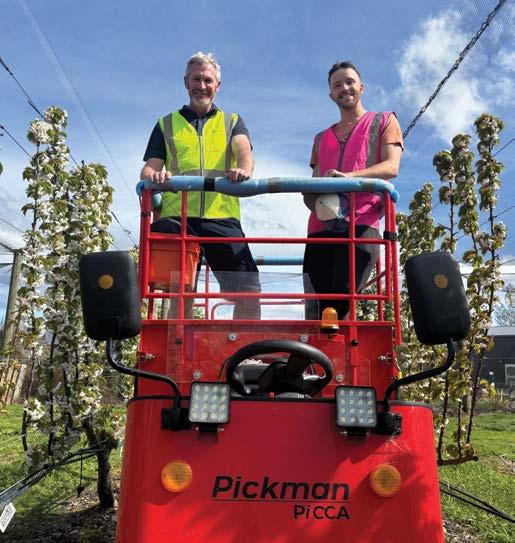

of a power outage on the grid
Homegrown electric sprayer
The electric tractor with sprayer attachment and the frost fans have been the most successful investments.
“The Monarch has proven that you can electrify tractors of that size. The tractor is at the centre piece of the whole operation,” he says.
You can attach welding tools to the back, along with the beer fridge and toastie pie machine as well if you want to.
The battery on the tractor supplies 100kW/h, which means they can spray for 10 hours, or mow for seven hours.
“This is what electric capable tractors are capable of right now and will only get better,” Euan says.
In fact the Californian founders of the Monarch tractor company were so impressed with the foliage sprayer attachment built by TRS made right here in New Zealand (Blenheim), that they bought two themselves for their own Monarchs back in the States.
Changing the sprayer’s power source from the power take-off to one that uses the tractor’s battery via two 230V sockets was a fundamental change to the way diesel tractors currently power sprayers.
“This means the runtime goes from two hours using the PTO (power take-off), to 10 hours using electricity – that is a massive increase in efficiency,” he says.
Collective goodwill
The electric frost fans were also the first in the country, and came from a company in South Africa called AGI, and run for about 200–250 hours per year.
Using grid power at wholesale price during spring when the lakes and power generation are high, frost fighting is fairly economical because of the low cost at this time of year.
Running at less than $1/hr on average compared to $50/hr for diesel, it was a no-brainer in cost savings on the orchard. Last season they only spent $220 on frost fighting, but Euan says orchardists can retrofit existing frost fans with electric capabilities.
The biggest challenge with changing to electric was that with the support network being so large (many of the suppliers are overseas), they can’t just ring someone to fix it.
“There is a lot of collective goodwill that makes this place successful. When you buy one of these things you are not alone.”
Euan has a direct number to a hotline for the managing director in South Africa if anything goes wrong with the frost fans – the bonus being, when he’s frost fighting in the middle of the night, the time zone overseas is the opposite.
No time for negativity
The 6ha orchard has achieved fully net zero energy bills for the past two years, and is now making enough surplus to send back to the national grid – effectively selling back about $200 worth of power a day during spring and summer.
The orchard generates about three times as much power than it uses in a year, and they are forecasting to make a healthy $40,000 a year from selling power back to the grid, on top of the 80–100t of cherries being exported.
Orchard manager and Electric Cherries shareholder Euan White with orchard technician Mahe Pivert, of France
A battery storage room holds 300kW/h – enough for frost fighting in the event
Added to the income stream are the ever popular orchard tours that now bring in an additional $20,000 a year – with several tours a month. So far they have hosted about 13,000 visitors.
But of course there are still the doubters. The people who turn up and ask, “is this actually a real thing?”
Euan was a soldier, a police officer and a mechanic in his past life, and says he has had to bring all of his skills to the table when dealing with negative comments –both in person and online.
There were some interesting comments on social media the day the Monarch tractor arrived.
“I hope your orchard burns down… or the tractor catches fire.”
The school mates don’t let the negative comments phase them. They have proven there is a market for sustainably grown fruit, “and our customers get our necessity about climate-related conditions,” Euan says.
Mike says their solar operation was not only good for the climate but also a smart business decision, “so why would they want us to burn down?”
Advice for other growers
Over the past year the orchard has produced 414.09MW/h of solar and only used 158.15MW/h.
A battery room holds 300kW/h of storage, which ensured there was enough power for frost fighting if there was a power outage on the grid.
There is a lot of collective goodwill that makes this place successful. When you buy one of these things you are not alone
Electric Cherries has proven in a short time that orchards can not only achieve zero energy bills, but also make power for the national grid and diversify their income streams. Now they are on a mission to help other growers do the same.
Euan and Mike’s first bit of advice for orchardists was to just replace one thing at a time to electric –rather than a huge investment from the get-go. When the irrigation pump breaks down, look at an electric option and whether they can pair with getting some solar panels too.
“Anything we do here can be applied to other places,” Euan says. “You have to have an open mind and just stick with things. There are electric options out there now and 90 percent of all machines have e-options.”





EPIC HISTORY OF NEW ZEALAND FRUIT GROWING
Former orchardist Chris Smellie’s new book Where have all the apples gone? is a collector’s item for everyone interested in the history of fruit growing. Created with great support from the New Zealand Fruitgrowers’ Charitable Trust, the book has been shortlisted for a global award and is available now.
Food is the first of the great pleasures of life that we experience and is the last to leave us. This book is about a group of New Zealand food producers for whom the taste experience is significant – orchardists and growers. The story covers the first inhabitants, the struggles between iwi and the changes wrought by the influx of European settlers and early land sales. Noting that the romance of rural life was not reflected by the reality of the financial struggles and the physically hard work and tough living conditions endured.
This book also covers the growth of the New Zealand fruit growing industry, its evolution and politics, ideological arguments over export markets versus local sales. The rise and demise of producer boards and co-operatives. Political views were often short-term, and not necessarily the same as those of the orchardists who were planting trees for the next generation. This is an epic history of
Huapai and Kumeū fruitgrowers and also the history of the New Zealand Fruitgrowers’ Federation.
...the ‘team’ of supporting trades and suppliers is an important aspect of this industry often overlooked
Deregulation of the New Zealand Apple and Pear Marketing Board (NZAPB) freed up the local market in the mid-1990s. The Board continued to be the sole exporter, and further changes followed. A new Act was passed in 1999 leading to the formation of a private company. The name ENZA appeared, then disappeared in 2001 when their position as sole marketer of pipfruit was revoked
Brian Neal in his favoured 1958 Eicher German air-cooled tractor which still runs and is on display at the Kumeu Show in March every year


by a new set of politicians. The following year the number of exporters increased dramatically, all competing to some extent with each other.
This is an epic history of Huapai and Kumeū fruitgrowers and also the history of the New
Zealand Fruitgrowers’ Federation
This is an interesting story for all food producers as it covers the specific area of Huapai and Kumeū in West Auckland while also acknowledging the national changes that impacted on the viability of all those early growers across New Zealand. The stories related by 16 local families will resonate in the Hawke’s Bay, the Bay of Plenty, Central Otago and Nelson where similar experiences by families could be related.
The extensive use of photographs adds value, along with the acknowledgement that the ‘team’ of supporting trades and suppliers is an important aspect of this industry often overlooked.
Interesting to skim through or to read in detail, this book fills an important gap in the New Zealand food producer story. Thoroughly recommended as a Christmas gift for rural families and for those involved in the trades and businesses which rely on the food producers.
ORDER NOW IN TIME FOR CHRISTMAS
Available directly for $49.00 from the Huapai Kumeū Lions Club by emailing sales.hklions@gmail.com. This price includes GST and courier delivery anywhere in New Zealand. Online payment and delivery advice will be sent for all enquiries. All proceeds from the sale of this book will be used in service projects in the West Auckland community through the Lions Club network.

has been
at the

for the
John Rosamond transferring Golden Delicious apples from his tractor in 1973
Louis Thackwray snr taking boxes of fruit to the railway station in his Warwick Auto Car in 1930s, the first car in the Huapai- Kumeū area
The new book
shortlisted
'Best Title' Award
31st Gourmand Awards, to be announced at the end of November in Saudi Arabia
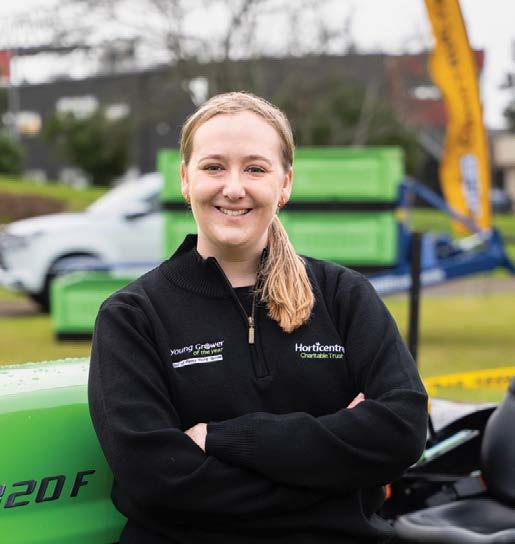

RURAL WOMEN GROWING THE FUTURE
During International Day of Rural Women in October, women across the country’s horticulture sector highlighted their role in building a more sustainable and resilient industry.
This year’s United Nations theme, ‘Rural women sustaining nature for our collective future’, recognises women’s contributions to biodiversity, climate resilience and land stewardship. In New Zealand, women in horticulture work across the entire value chain – from orchards to research labs, boardrooms to packhouses.
The sector has made considerable progress in advancing women into governance and senior leadership roles. Initiatives like Women in Horticulture highlight leadership pathways, networking opportunities and greater visibility for women throughout the fresh produce industry.
Finding opportunity in horticulture
Kirsti Lovie, business performance and sustainability manager at Craigmore Sustainables and associate director on the HortNZ Board, says she “fell into horticulture” and discovered a passion for it.
“I was working in dairy and I met my partner through Young Farmers and started helping out in his family vegetable growing business,” she explains. Twelve years on, she and her partner are taking over that business – 120 hectares in Canterbury growing crops including potatoes, brassicas, sweetcorn and process vegetables.
When it comes to women in the sector, Kirsti sees more opportunities than challenges. “There are so many career pathways and already many examples of women in prominent leadership positions from boards to product groups to HortNZ.”
She credits supportive networks and leadership programmes for her own development. “Mentoring, micro-credentials, governance training – the pathways are there. Now we need to keep communicating that.”
Kirsti notes that women often bring different approaches that add value. “I think women bring different skillsets that
Phoebe Scherer, the newly crowned Young Grower of the Year 2025, is a lab manager at Apata in the Bay of Plenty
Manpreet Kaur is an assistant orchard manager with T&G Global in Hastings
run parallel with other approaches. There is not a right or a wrong way but there is that very empathetic and supportive element.”
Building career pathways
Manpreet Kaur’s journey shows what’s possible with the right support. The assistant orchard manager with T&G Global in Hastings started in the packhouse in 2009. Now a HortNZ Leadership Scholar, she mentors others on their career paths.

“When I joined the sector, there were only three or four women in my area of the business and now they make up more than half our staff,” Manpreet says.
She’s completed all levels of the NZ Certificates in Horticulture and achieved the NZ Diploma in Horticulture Production Level 5, with strong encouragement from her employers. “There are so many different career opportunities in the sector, indoors and out, and women can do any of them.”
One of the best parts of her job, she says, is being able to motivate and encourage other women. “Empowering people is what I am passionate about.”
For Manpreet, International Rural Women’s Day is about “celebrating the community, the skills, the determination and resilience of rural women and the ability to uplift one another – and communicating that to future generations”.
A different path in
Phoebe Scherer, the newly crowned Young Grower of the Year 2025, represents a newer generation entering the sector. The 29-year-old lab manager at Apata in the Bay of Plenty didn’t grow up on a farm but found her way into horticulture after gaining a Bachelor of Science in biology and doing her OE.
“You don’t have to grow up on a farm or growing operation,” Phoebe says. “You can come from any background and become a rural woman but it is the community that is all-important to attracting, supporting and retaining people with key skills.”
Kirsti Lovie is business performance and sustainability manager at Craigmore Sustainables and associate director on the HortNZ Board
She took a seasonal job “counting kiwifruit” with Fruition in 2018, which led to an assistant consultant role and eventual promotion to horticulture consultant. She credits good mentors at both Fruition and Apata for conveying their passion for the industry.
Phoebe sees recruitment and retention as the sector’s biggest challenge, with effective mentoring and community essential for supporting rural women. “The community and friendships I have gained in horticulture have also been instrumental in me staying in the sector. We are so supportive of one another.”
She notes that while she sees as many women as men entering the sector now, attitudes have shifted. “When I first joined, I would go to events with a male colleague and people would shake his hand but not mine. That doesn’t happen anymore.”
Looking ahead
As Stephanie Wrathall, United Fresh’s project manager for Women in Horticulture, puts it: “Whether it’s managing orchards, leading research or sitting at the board table — rural women are at the heart of a thriving, sustainable future for horticulture in Aotearoa.”
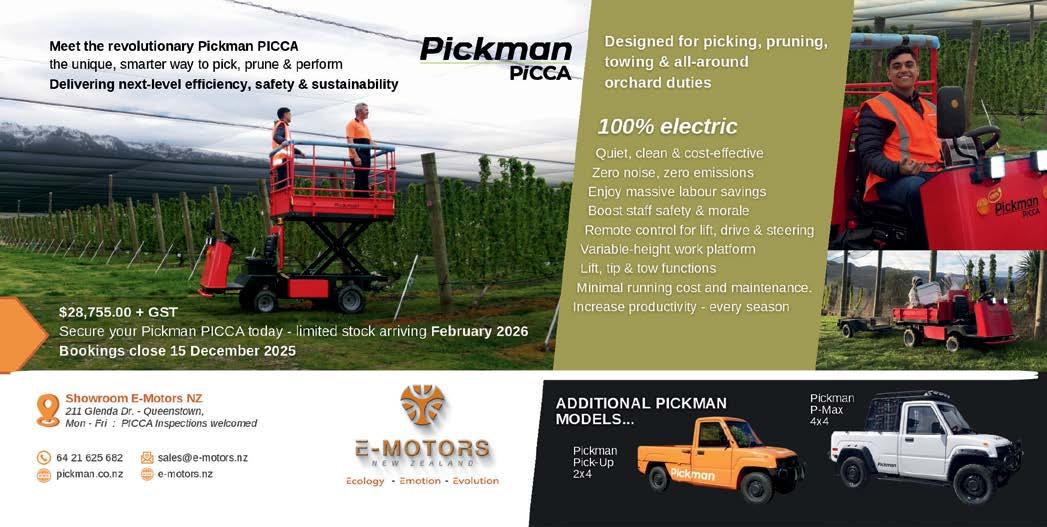
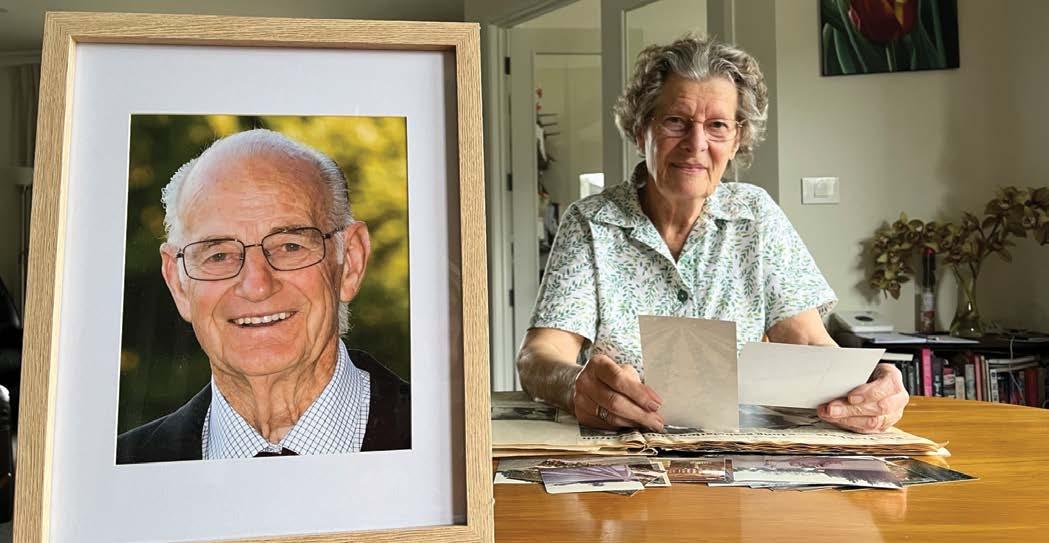
EVERYBODY KNEW DEKKERS
Margaret and her late husband Johan Jozef “Jim” Dekker are horticulture royalty in the Wairarapa, where the Dutch couple were the first and only commercial strawberry growers in Masterton for three decades.
Carly Gibbs
Margaret Dekker is the first to admit that 60 years ago, she hardly knew the difference between a tulip and a daffodil. However, her green-thumbed late husband did, and would lead them on a journey that became their lives’ purpose.
Margaret and Johan Jozef “Jim” Dekker are big names in the Wairarapa, where for 35 years, the Dutch couple grew tulips, tomatoes and cucumbers, and were Masterton’s only commercial strawberry growers.
Even today, there are fewer than 10 commercial strawberry growers in the Wairarapa/Horowhenua, forming part of a broader national supply chain centred around large-scale, centralised distribution centres.
Affectionately known in Masterton as “Mr Strawberry”, Jim died from heart failure in February, aged 94.
It brings a smile to Margaret’s face when she talks about his grower legacy, and another when she shares that at 87, she still grows tulips, vegetables and strawberries – just a tiny harvest now – enough to fill her kitchen sink.
Jim died two months before their 65th wedding anniversary. And 10 months prior, they lost their youngest child, Selma, to cancer. It’s been a tough 18 months for Margaret, but looking back, she is proud of their journey, and Jim, who was never one “to put his chest out”.
Instrumental legacy
Jim’s humility is likewise remembered by Antonia Crawford, executive manager of NZ Berryfruit Propagators. Antonia says Jim was “unassuming” and not “a flashy leader”, but got things done. He was a founding member of New Zealand’s berryfruit organisations and served as an advisor during their various transitions.
Margaret and her late husband, Jim, are well-known figures in the Wairarapa, where, for 35 years, the Dutch couple were Masterton’s only commercial strawberry growers. Photo by Carly Gibbs
“He was there at the beginning of all the structures, which helped govern the whole of the berryfruit industry.
“Jim was instrumental in our developing a relationship with the University of California, and that is where we still get the main varieties that are grown in New Zealand,” she says. “Up until 10 years ago, we were the only company in New Zealand that was importing new material.”
Margaret and Jim moved to New Zealand separately after World War 2 and met at a Catholic mass in Masterton for Dutch immigrants. They married in 1960 and established Dekkers Gardens, featuring three different crops, on a former 2-ha poultry farm on Kibblewhite Road.
Even today, there are fewer than 10 commercial strawberry growers in the
Wairarapa/Horowhenua
Alongside strawberries, the couple and their five children grew Taupo tomatoes and Telegraph cucumbers in three glasshouses, as well as various tulip varieties. Jim was the first Kiwi grower to produce tulips out of season, planting 5000 bulbs each year and growing over a million flowers by the 1990s. Their property also delivered industry firsts in strawberries – first with Red Gauntlet and Talisman, and later Camarosa, which he introduced to New Zealand.
Margaret explains that while nearby Greytown, with its rich river soil, was well-known for strawberries, it was widely thought you couldn’t grow them in Masterton, but Jim proved otherwise.
“Jim knew soil,” she says. “He had always been working in the soil in Holland since he left school and was working with the local farmers there and (in New Zealand) before starting his business. He could read plants well.”
Margaret’s job was to run their popular on-site shop.
“Everybody knew ‘Dekkers’,” she smiles. Christmas Eve, when sun-ripened berries were at their sweetest, their shop was a “madhouse”. “We had a kilometre queue out of the gate and onto the road.”
On a wider domestic front, the Dekkers were one of 13 Wairarapa growers to sell fruit by the tonne to ice cream brand Tip Top and Hutt Milk for yoghurt.
Margaret was the group’s secretary. At the time, the Dekkers ran a seven-day-a-week enterprise.
“If it were only berryfruits, you got time off during the winter, but we went from berryfruit into the flower season, and after the flowers, we went back into the strawberries, and that was followed a few weeks later by tomatoes and cucumbers.”
OVER THE LAST 30 YEARS 100 VARIETIES OF STRAWBERRIES HAVE BEEN TRIALLED IN NEW ZEALAND CURRENTLY ABOUT 15 VARIETIES ARE GROWN COMMERCIALLY
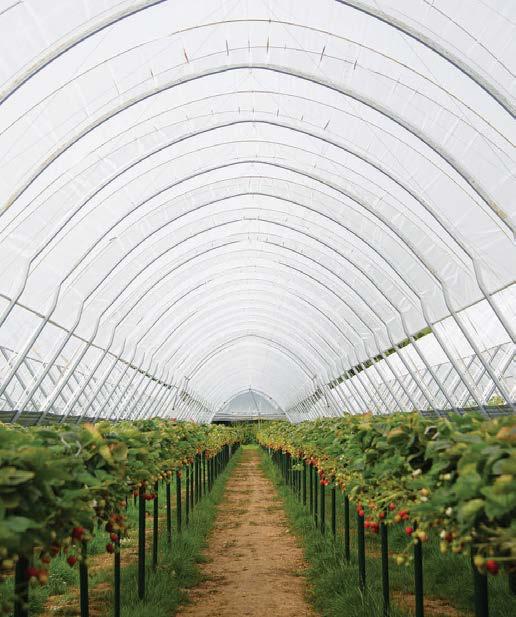

QUALITY PolyTUNNELS & Substrate Systems
Built For Growers, By Growers


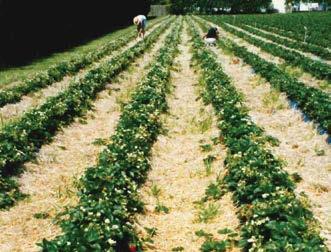
Changing times
Before polythene came along, the Dekkers laid straw in between their plants, and it was a traditionally summer-only season.
Nowadays, covered crop growers provide fruit from September through May, and more strawberries are grown hydroponically on tabletops; however, strawberries remain a temperamental fruit to grow on a large scale.
Sally King, executive manager of Strawberry Growers NZ, says the industry is experiencing rapid consolidation in strawberry growing operations compared to the Dekkers’ era.
“What used to be generational growers on relatively small acreage or hectares of field strawberries is now a much larger 10 hectares of covered crop. The industry is shifting quite quickly to the extent that eight growers now have more than 50 percent of the plants sold. At the same time, we’ve shifted from growing mostly University of California NZ Berryfruit Propagators brands to a much wider range of plant varieties through Driscoll’s and others.”
“Not all of them are accessible because we don’t have direct flight links,” Sally explains. “And it’s not like you can have strawberries sitting on an Abu Dhabi airport unchilled.”
Margaret recalls that she and Jim attempted to export to Holland, but it was a challenging endeavour.
“We had to truck strawberries to Wellington, and from Wellington, they had to be flown to Auckland, and you were hoping they’d get them on the right plane as quickly as possible.” In the Dekkers’ case, it was a disaster.

That whole idea of a summer treat that connected communities (aka pickyour-own days where kids would ‘eat themselves silly’) is dwindling, Sally says. There is a broader range of different strawberry plant varieties, along with various new cropping techniques. Indoor growing means there’s less local competition. Barriers to exporting have become higher. Despite the industry’s access to 50 countries, berries need to be air-freighted, and this depends on aviation schedules aligning with those markets. The air freight industry is still recovering from the Covid-19 pandemic.
Their strawberries were unloaded in Honolulu and left baking on the tarmac until the following day. “When they arrived in Holland, the juice was dripping out, so no more,” she says.
Good memories
The Dekkers retired to Tauranga in 2013. In Masterton today houses cover where their garden beds, greenhouses, coolstore, packing shed and freezer room used to be. After selling up in the late ‘90s, they shifted elsewhere in Masterton and assisted Massey University-led trial gardens.
Looking back at old photos and newspaper clippings of hardworking times, Margaret is eager to tell Jim’s story because he was never one to seek recognition.
“Jim was the eldest son of eight children in a poor family. He left school at 14 and, at 19, had to enlist in the army for nearly two years,” she says.
Jim moved to New Zealand at 26, from the north-west of Holland, on his own. Margaret came from the east at the age of 18 with her family.
“I am absolutely proud of him coming to New Zealand on his own and for what he achieved.”
Before polythene came along, the Dekkers used to use straw between their plants. Photo courtesy of the Dekker family
Margaret was secretary and treasurer for the Wairarapa Berryfruit Association, at the same time that Jim was chair. Photo courtesy of the Dekker family
Jim and Margaret are pictured at a horticultural event in 1981. Photo courtesy of the Dekker family
The Dutch are masters of tulip horticulture, and Jim (pictured here in 1985) showed off that skill in Masterton, growing fields of unfurled tulips in a variety of colours and shapes. Photo courtesy of the Dekker family
I think how great it is to be involved in something that is going to be here well after I’m gone

MITIGATION THROUGH BIODIVERSE WETLANDS
Baygold’s wetland, Te Rere Maniatutu, is thriving with life after the realisation of a big dream and four years of dedicated stewardship.
Carly Gibbs
When the kiwifruit development and management company, Baygold, bought a big chunk of land in Pongakawa in 2021, wildlife was not their immediate focus. However, it soon became an unexpected priority.
“I feel extremely proud of it,” says Olivia Manusauloa of a 3.5ha dark-pooled wetland hemmed with emerald borders, which Baygold developed on the same site as their head office and 16ha orchard, named The Station.
Te Rere Maniatutu wetland is home to a thriving ‘city’ of pūkeko, the endemic weweia (dabchick), as well as other species like the mallard duck. It is also thickly blanketed with 50,000 native plants, including flax, mokuautoto (joined twig-rush, Machaerina articulata), and kāpūngāwhā (lake clubrush, Schoenoplectus tabernaemontani), as well as protected tōtara and rimu.
Wetlands play a crucial role in flood mitigation and water filtration, acting like a sponge. During drenching rains, they expand, collecting excess runoff. Wetland plants filter the stored stormwater – removing sediment, nutrients and bacteria – before it bleeds into nearby estuaries.
Wetlands also provide a biodiverse, nutrient-rich habitat for aquatic and semi-aquatic animals and contribute to climate change mitigation by storing carbon.
“I think how great it is to be involved in something that is going to be here well after I’m gone,” Olivia enthusiastically shares.
As Baygold’s relationship and sustainability manager, Olivia was the driving force behind Te Rere Maniatutu, which, alongside the family-owned Hickson (Pongakawa) wetland, recently won Environmental Sustainability Project Awards at the 2025 Water New Zealand Excellence Awards.
Te Rere Maniatutu was the brainchild of Olivia Manusauloa, Baygold’s relationship and sustainability manager.
Photo by Luke Edwards
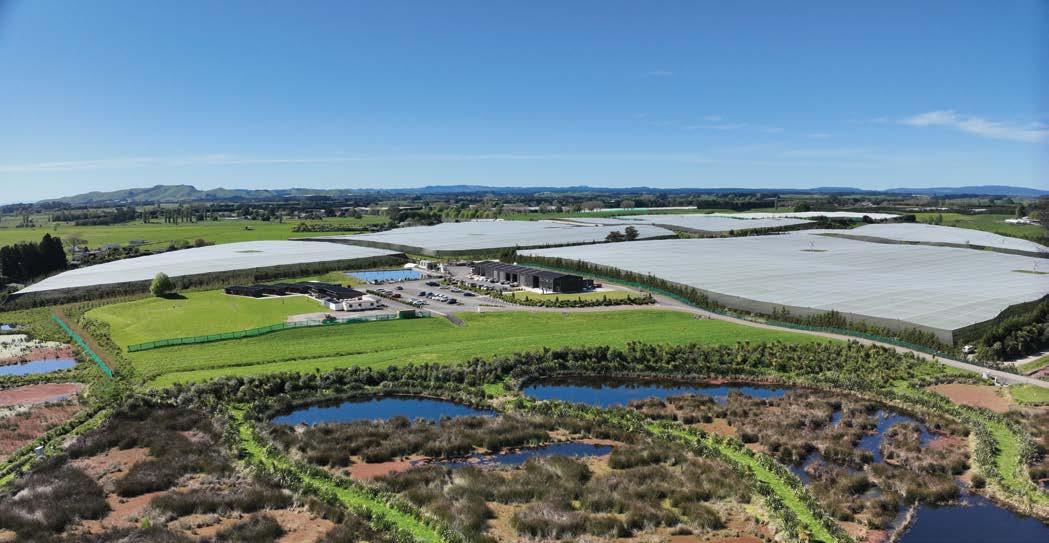
Just add water: The award-winning Te Rere Maniatutu wetland is home to a diverse array of birdlife and 50,000 native plants.
Photo by Luke Edwards
Big dreams
Baygold owns 400ha of Zespri SunGold™ across Te Puke. When they relocated their original office from Roydon Downs Road to Maniatutu Road in 2021, the site offered a unique opportunity for landscape development from scratch. With a background in landscape architecture, Olivia had big dreams.
She explains that the Bay of Plenty Regional Council was keen for Baygold to implement on-site water storage. Instead of a traditional sediment retention pond, she proposed developing a wetland in a floodprone area of the property.
After gaining management approval and discussing the idea with the Bay of Plenty Regional Council, Olivia discovered that council was already exploring sites for a new study on constructed wetlands and their effectiveness. With partial funding available, Baygold entered a partnership with iwi Ngāti Pikiao, the council, and the Sustainable Land Management and Climate Change programme, funded by the Ministry for Primary Industries. The wetland is located in the Wai Kōkopu subcatchment of the Little Waihi Estuary, helping to slow and filter water. Traditionally considered a ‘poor catchment’, Te Rere Maniatutu is one part of a larger community initiative to transform that.
“The Waihī Estuary, tucked between Maketū and Pukehina, is a special natural taonga that’s been under pressure for years,” Olivia says. “Runoff from surrounding land and waterways has brought in high levels of nutrients like nitrogen and
phosphorus, along with sediment and faecal bacteria, which have really taken a toll on the estuary’s health.”
Recently, New Zealand Food Safety issued a warning advising people not to eat shellfish gathered from the estuary. “Tests showed toxin levels in the shellfish were more than double the safe limit – pretty alarming stuff, especially for locals who’ve relied on that kai for generations,” she says. “We see this wetland as a vital step toward restoring the estuary – laying the groundwork for a healthier future for generations to come.”
Runoff from surrounding land and waterways has brought in high levels of nutrients ... which have really taken a toll on the estuary’s health
Jack Turner, director of the engineering, environmental, and planning firm Tektus, assisted both winning Pongakawa wetland projects and says that ongoing water quality monitoring indicates results that are “currently off the charts”.
Baygold constructed Te Rere Maniatutu in two stages. The first stage, covering 1.9ha with a catchment area of 73ha, was completed in 2021. Regular monitoring has shown that 2.5 percent of the water is filtered through the wetland. The second stage, completed this year, is 0.7ha and filters one percent of water from a 67ha catchment.

Baygold worked with consultants Tektus and eco-sourced plants and seedlings from Naturally Native. Photo by Luke Edwards
Big plans
Baygold collaborated with Les Anstis from Naturally Native to select eco-sourced plants and seedlings, some of which were required by Earth Sciences New Zealand (formerly NIWA) for their specific ‘skillsets’.
Additionally, an archaeologist inspected the soil before earthworks and conducted carbon testing on soil fragments, identifying pioneer tree species such as kahikatea and kauri in the peat.
They were then able to confirm what species historically existed, which was crucial for restoration.
The team carefully calculated the choices of which species, how much of each, and where to place them to achieve the correct life cycle of a forest.
Baygold also took advice from Zespri’s native planting plan for kiwifruit orchards, which specifies plants known to host problems like passionvine hopper, and eliminated those from consideration.
Learned advice
Olivia’s advice for growers considering building their own wetland is to factor in costs and time, recognising that it’s not a quick process. Engaging experts and committing to upkeep, including seasonal spraying, is vital.
“It might be cheaper at the start to have wider spacing of plants, but then the weeds take over,” she cautions. “So, tighter spacing. It’s a long-term investment, and if you do it well, it certainly pays off.”
CONSTRUCTED WETLANDS AS A MITIGATION TOOL
Earth Sciences New Zealand has been leading initiatives with industry partners and farmers to support the uptake of constructed wetlands as a mitigation tool to reduce diffuse contaminant losses from productive land use.
Case studies show that as constructed wetlands increase in size from one to five percent of their contributing catchment, they can reduce more of the nutrient and sediment loads they intercept.
In warmer areas, nitrate removal ranges up to 50 percent; wetlands up to five percent of the catchment area can remove up to 48 percent of total phosphorus; sediment load reductions range from 50 to 90 percent. First wetland established 2021
WETLANDS
Second wetland established 2024
total size of area planted, including native bush surrounds
Having seen the impact of Cyclone Gabrielle in 2023, when drone footage revealed neighbouring properties submerged while Te Rere Maniatutu held Baygold’s share, Olivia reflects, “It certainly helped hold and slow down a large amount of water that would have otherwise increased the flooding on the other side of the road and flowed down onto the flats.”
Olivia says that Baygold didn’t create the wetland for kudos; instead, it aligns with their philanthropic philosophy of giving back and continuing their tradition of developing world-class orchards that consider the site as a whole.
“This award is a reflection of our deep commitment to environmental stewardship,” Olivia says. “We had the opportunity – and with that comes a responsibility to do more.
“Creating the wetland wasn’t something we were required to do, and it came at a significant cost. But we chose to invest in it because it truly reflects what we value. It’s about doing the right thing, not just the expected thing.”
BAYGOLD

THE COST
If you supply drinking water on your orchard or farm, you may have obligations to provide water that’s treated and safe to drink. New Zealand’s Water Services Authority – Taumata Arowai has updated rules making drinking water compliance easier for growers. Chief executive Allan Prangnell calls the changes a game-changer, enabling simple and affordable actions for rural schemes.
Tim Cadogan : Water Services Authority – Taumata Arowai engagement specialist
Across New Zealand, schemes have been set up to get water onto land in support of horticulture. These schemes have evolved over time and, while designed primarily for horticultural purposes, many now also provide drinking water to homes, workers’ accommodation and local businesses.
Safety requirements for drinking water in New Zealand have come into focus over the last few years, with the Water Services Authority – Taumata Arowai (the Authority) set up in 2021 to oversee New Zealanders’ access to safe drinking water.
The Authority’s first priority has been getting council supplies across the country up to scratch, with over 80 percent of New Zealanders on council-operated supplies. Positive progress with our public supplies means attention can broaden out to the safety of supplies for communities
not hooked up to the local town supply. Growers may have obligations under the Water Services Act for drinking water compliance, including registering with the Authority.
Allan Prangnell, chief executive of the Authority, acknowledges the position growers may find themselves in.
“A number of growers find themselves supplying drinking water and, like anyone, don’t want to make anyone sick even if running a drinking water scheme isn’t the primary focus.
“Having spent time recently with those involved in small, often rural water supplies, what I took away was the importance of clarity and simplicity – making sure a supplier’s obligations are practical, fit the local circumstances and are administratively efficient. For those consuming the water on these supplies, affordability and reliability are important considerations.”
With those factors top of mind, the Authority recently introduced a compliance package specifically for smaller, rural water supplies. Allan says growers can continue to provide drinking water that’s treated, safe to drink and comes with minimal hassle, “so you can get on with your core business with peace of mind.”
Recently, the Authority published three updated sets of rules called Acceptable Solutions, with making compliance for providing safe drinking water easier and more affordable for rural water schemes firmly in mind.
Acceptable Solutions were first introduced over three years ago but have been significantly revamped. If growers had rejected the previous Acceptable Solutions, the new versions may change that thinking.
A key feature of Acceptable Solutions is that they enable water to be treated to make it safe near the buildings where people will drink it. These devices filter and then treat the water with ultra-violet (UV) light and are an alternative to having treatment done at the start of the supply, which is impractical when most of the water isn’t being used for drinking.
Core to the recent changes is the type of treatment units approved for use. Previously, these units had to be validated to international standards. This requirement has been removed for use by households and private workplaces supplying 25 or fewer people, taking the price per unit from around $10,000 to under $1,500. The more expensive “validated” units are now only required where extra protections are necessary such as for cafes, schools and public halls.
One validated unit can now also be used to treat drinking water for up to 10 buildings on the same property. For example, water treated in the cookhouse can then be piped to separate workers’ accommodation units in most circumstances.

UV devices approved under the old Acceptable Solutions are still recognised under the updated versions. However, the Authority has made some of the supporting requirements easier.
Allan also encourages growers who supply drinking water to register with the Authority.
“We are here to help growers ensure drinking water is safe and, alongside the new Acceptable Solutions, the best way we can do that is by encouraging people to get registered. Once registered, the Authority can share updates and advice to support good practice.
“Safe drinking water will always be our priority. We recognise our role in enabling the diverse range of suppliers across the country to take simple and affordable actions towards safer drinking water. The new Acceptable Solutions are a game-changer for small schemes to achieve this.”


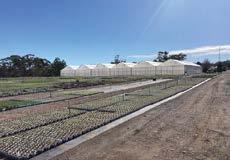

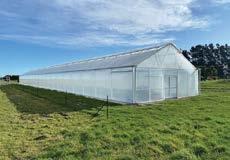
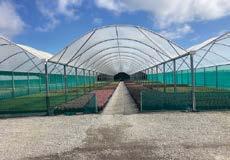

After public consultation on the Gene Technology Bill, the Health Select Committee recommended several amendments
WHAT’S HAPPENING WITH GENE TECHNOLOGY?
Last month Parliament’s Health Select Committee finally reported the Gene Technology Bill back to the House.
The Gene Technology Bill aims to enable the safe use of gene technology in New Zealand by establishing a new regulatory regime for gene technology and genetically modified organisms (GMOs). The bill would also establish an independent Gene Technology Regulator within the Environmental Protection Authority.
After public consultation closed in February this year, the Health Select Committee considered submissions from 14,458 interested groups and individuals and heard oral evidence from 287 submitters.
The committee recommended several key amendments in its report, but the bill is awaiting its further parliamentary stages before becoming law. Industry bodies are currently absorbing the impact of these changes on horticulture before providing input on the regulations that will support the bill and the new regulatory regime.
Look out for future articles in NZGrower & Orchardist as more details become available.
www.parliament.nz

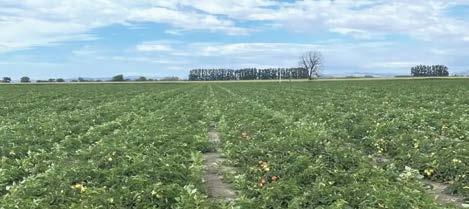
aid land managers and policy makers
CYCLONE GABRIELLE RESEARCH SYMPOSIUM
Vegetable Research & Innovation, LandWISE and FAR are hosting a research symposium to bring together those involved in reacting to Cyclone Gabrielle’s impacts on highly productive land. The symposium will explore findings and observations and together draw out lessons to aid land managers and policy makers in future events.
• What seemed to work and what didn’t?
• What was not studied and should have been?
• What resources can be prepared that others can easily access and use to guide decisions immediately after such events, and in the months and years to follow?
Follow the QR code for more information and to register. Wednesday 10am, 19 November to Thursday 3pm, 20 November
Havelock North Function Centre, 30 Te Mata Road, Havelock North
events.humanitix.com/ cyclone-gabrielle-researchsymposium


An upcoming symposium explores Cyclone Gabrielle research findings to
in future events
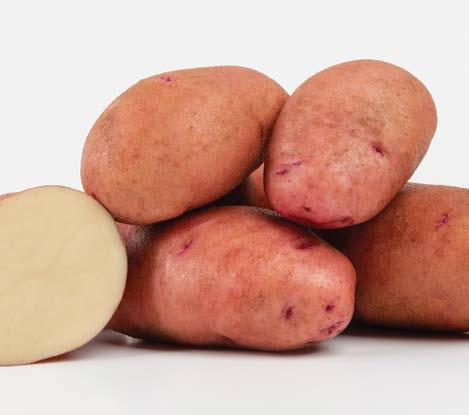
New Zealand developed ‘Crop78’ is becoming a popular variety with global French fry processors
NEW POTATO WINS INNOVATION AWARD
A new potato cultivar, ‘Crop78’, was recognised at this year’s KiwiNet Research Commercialisation awards for delivering outstanding innovation performance and impact for New Zealand.
Developed by the Bioeconomy Science Institute (Plant & Food Research), ‘Crop78’ is a diseaseresistant, resilient potato cultivar with excellent cooking quality that consistently delivers high yields with lower inputs and is sought after by French fry processors.
‘Crop78’ is being commercially produced in New Zealand and Australia, with trialling underway in North America, Europe and India, and is being increasingly used by quick service restaurants for its consistency and performance.
Bioeconomy Science Institute’s business development manager Barry Cowen and science group leader Samantha Baldwin accepted the award from Anton Blijlevens from AJ Park, sponsors of the Commercial Impact Award.
www.bioeconomyscience.co.nz
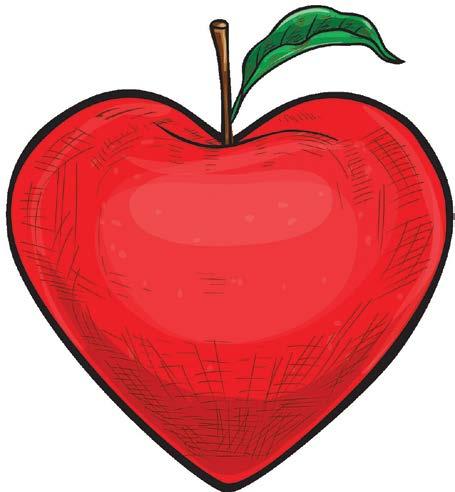
The new fungicide on orchard blocks, Property, delivers outstanding control at all infection stages of powdery mildew.



We have developed and tested ‘Tagga’ which combines Green Atlas orchard scanning with a GPS-guided line marking machine to first map and then precisely mark the sections of an orchard that need thinning

A GPS-guided line marking machine precisely marks the orchard sections that need thinning
SEEKING PRODUCTIVITY GAINS
Jack Hughes : Fruition horticulture consultant
Setting the scene
The rising cost of living and New Zealand’s lacklustre productivity have been in the news lately and not in a good way. Cameron Bagrie, not one to mince words, frames these issues as a serious problem requiring urgent action on many fronts. He quotes alarmingly negative national business productivity statistics and says we must aggressively cut costs and invest in capital and labour productivity. In this article, I’d like to discuss how we’re doing in our industry.
There are two perspectives on rising wages – for employers they are far and away the biggest cost to orchard businesses, whereas for employees, wages pay for the ever-increasing cost of living. Natural tension there, for sure.
Perhaps a happy medium lies in increased productivity, with the employer getting more done for every dollar spent and the employee being paid a living wage. There is a qualifier to productivity – it is not just getting more done but getting ‘more done well’ that is needed.
Let’s break the productivity investment discussion into the two components that Cameron described.
Capital
I believe our record for capital investment in productivity can be defended, as a lot of industry efforts have gone into improving orchard growing systems. There is a nice payoff to better canopy design where improved light interception also gives improved accessibility to manage the crop – orchard productivity and labour efficiency both get better.
In apples, there is arguably a consensus that we want planar (thin) canopies fruiting on vertical stems. Then it is a question of how many stems per hectare and how to arrange them for productive and logistical efficiency.
In kiwifruit, the uniformity of the pergola has long surpassed the variability of the T-bar. Since then, many improved ways to arrange males and replace fruiting canes have been developed.
Labour
Mmmmmh, not looking so flash here. It could be argued that we have relied on the work rate and stamina of Recognised Seasonal Employer (RSE) workers and the enthusiasm of backpackers to carry the day. Methods for establishing, describing, implementing and quality checking crop targets have not changed much over time.
I think the goal of crop management is making it easy for staff to do things well. Let’s dive a bit deeper…
Kiwifruit and apple crop management
At Fruition, we are fortunate to be working with clients in both kiwifruit and apples, allowing us to compare and contrast physiology of the crops and different approaches taken to growing them. We think the productivity objective in both crops is the same – the sooner, cheaper and easier you get to optimum crop load the better.
Kiwifruit
In kiwifruit, winter chill and dormancy breakers strongly influence bloom density and the number of side flowers. Early evaluation of the crop density (ultimately fruit per square metre) helps to decide the best strategy, as manual adjustment is the only option.
Growers have different preferences for getting to target crop load, both in method and timing. When density is high, it could involve whole shoot removal. When bloom density is low, it may mean holding off until after fruit set to reassess.
We want a uniform crop, but Green Atlas Cartographer crop density scans usually show that the starting point is variable across orchards – usually way more than we imagine – making labour management a big challenge.
Apples
Apples are similar to kiwifruit in that crop regulation starts with winter pruning. In kiwifruit, almost everyone wants somewhere from 30 to 35 buds/ m² whereas apple targets vary depending on a host of factors. There is potential to standardise apple pruning techniques over different growing systems to unify the approach taken to subsequent crop load management. Simplified branch form provides an opportunity to use ‘fruit/metre’ as a measure of crop load, adjusted for each variety. This is particularly useful as it automatically adjusts for the fruiting capacity of different sized trees.
Chemical thinning provides a labour-free option to reduce excess fruit numbers. There are many variables and challenges at play, but we need to develop and adopt tools that reduce the subjectivity involved and provide more informed decision making.
When
density is high, it could involve whole shoot removal.
When
mean
bloom density is low, it may
holding off until after fruit
set
to reassess
Post-drop fruit set typically exceeds target, but the high cost of hand thinning and the productivity cost of carrying surplus fruit longer provide strong incentives to improve the precision of winter pruning and chemical thinning.
Propagators of Gisela® cherry rootstocks and Geneva® apple rootstocks.
Waimea has been at the forefront of bringing new rootstocks and varieties to NZ, to assist growers in having some of the most highly efficient and productive orchards in the world.
We are pleased to be continue this with the production of trees on Gisela® cherry rootstocks and Geneva® apple rootstocks.





Please contact the Sales team to discuss availability:
Grant Bryan, 0274 201 003, grant.b@waimea.group
Kate Marshall, 0274 201 033, kate.m@waimea.group


www.waimeanurseries.co.nz

When
the gang arrives
Here’s the kicker. In both crops we have repeatedly seen from pre and post thin scans that workers will remove a similar number of fruit throughout a block. Crop density is reduced but variability is not. This shows that it is hard for people to adjust to crop load variability and improve uniformity. No blame here – it is just really difficult to detect gradual changes in crop density whether you are skilled or unskilled, an RSE worker, a backpacker or a Kiwi.
The feedback we were getting from orchardists was ‘your fruit density scans are great at highlighting variability, but how do I make sure my staff address that variability correctly?’
Empowering growers
We realised a bit of ‘techy innovation’ could help, and have developed and tested ‘Tagga’, which combines Green Atlas orchard scanning with a GPS-guided line marking machine to first map and then precisely mark the sections of an orchard that need thinning.
The map followed by tag approach allows decision-makers to review the scan and decide what action they want to take. They set the crop density threshold, and we produce and download that prescription map (image above) to Tagga to physically lay out those instructions in the block. The Tagga unit (image on page 30) is then towed around the orchard by an ATV (all-terrain vehicle), automatically spraying the ground to clearly and precisely mark only the areas outside the pre-determined threshold.
This saves time by keeping workers out of the areas that don’t need thinning, and more importantly saves crop by avoiding unnecessary thinning where crop density is already at or below target.
Testing 1, 2, 3
Trials conducted on a kiwifruit orchard in the 2024–25 season showed significant labour savings and much more targeted crop removal. Two comparable 1ha blocks were used for the trial, with Tagga line markings used to guide fruit thinners on one block while traditional thinning instructions were used on the control block.
On the Tagga block, labour time for fruit thinning was 35 percent less than the control block, and 60,000 fewer fruit were removed compared to the control block where the workers were ‘flying blind’.
Alex Hoek, Fruition’s Precision Hort manager, summed the result up nicely – “considering the value of gold kiwifruit, saving just 1000 good pieces of fruit from being thinned paid for the Tagga application. Add to this labour savings and potential fruit quality gains, it’s clear this can be a powerful tool for growers.”
We like the fact that Tagga still lets the orchard manager pull the levers. It also leaves scope to adopt better measures of crop load. Using an apple example, setting ‘fruit number per cubic metre of canopy’ adjusts for different tree size, avoiding undercropping larger trees and overloading smaller ones.
Objective measures of crop load also increase accountability. A post-thin scan shows what has been done. The conversation between grower and contractor could be ‘come back and fix these missed bays and this under-thinned area’ or ‘thanks for a great job, you’re on target and uniform throughout. Here’s your bonus.’
A high value crop can easily fund the reward.
The orchard scan identities crop density variation
Stops feeding faster
Improved attraction and palatability quickly halts feeding, resulting in a 90% reduction in damage within three days.
Farmer and environmental safety
The active ingredient Feralla® is a safer choice for both farmers and the environment.
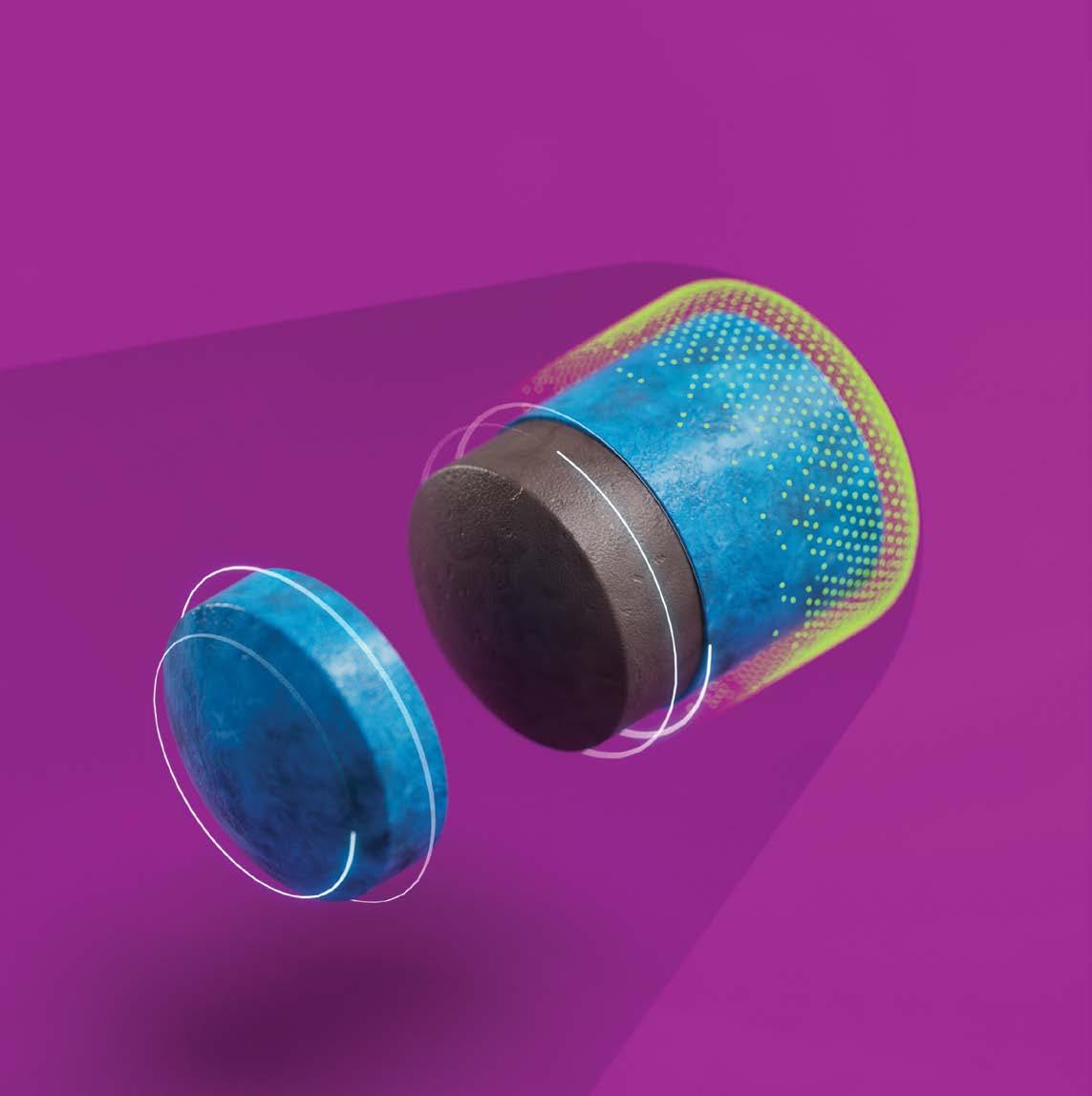
Prolonged efficacy
Superior mould resistance and pellet integrity thanks to Desidro® Technology.

Ferrabait®: A new standard in slug and snail control
Our innovative pellet is engineered with proprietary formulation and drying technologies, delivering maximum efficacy and prolonged use in the field while being safe for farmers and the environment.
Get your Ferrabait® pellets today, contact your local ADAMA Commercial Manager or visit Adama.com
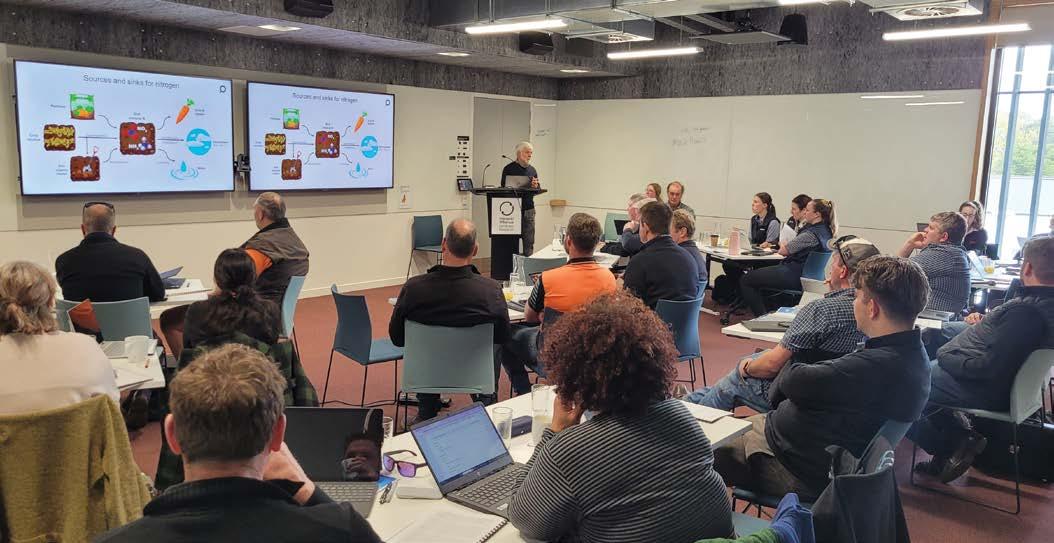
The SVS team are planning on taking the regional workshops (such as pictured above in Lincoln last year) a step further – by meeting quarterly to refine the SVS Tool, track crops and integrate the tool into fertiliser decision making
BALANCING THE EQUATION: HOW THE SVS TOOL HELPS GROWERS OPTIMISE NITROGEN
Nitrogen plays a crucial role in the growth of vegetable crops. Too little nitrogen limits plant growth and reduces marketable yield and quality, while too much also reduces yield and quality, and increases costs and environmental risk.
Andrew Barber : Agrilink managing director and Daniel Sutton : Vegetables NZ research development and extension manager
The challenge for growers has always been finding the right balance, getting enough nitrogen to support the crop, but not more than the system can efficiently use. Having the right information and knowing how to interpret it is key to achieving that balance.
The Sustainable Vegetable Systems (SVS) programme, an industry-led research and extension initiative funded by the Ministry for Primary Industries (MPI) in partnership with Potatoes New Zealand, Vegetable Research & Innovation and HortNZ, set out to make this easier. SVS built a robust
nitrogen (N) knowledge base for New Zealand’s vegetable rotations and translated it into a practical, grower-facing decision support tool. The SVS Tool creates a nitrogen budget. Just like a financial budget it has inputs (income) on one side (mineral N at planting, N fertiliser, soil mineralisation and crop residues), and outputs (expenses) on the other (crop N uptake, losses below 30 cm, and mineral N level at harvest).
The budget provides nitrogen fertiliser guidance, but more importantly forms the foundation for a discussion and decision making on a nitrogen fertiliser plan.
Focus areas for SVS Tool
Since the SVS Tool was launched in August 2024, one major focus has been training nutrient advisors on the use of the tool and gathering their feedback for further improvements. Supported by Te Tautara o Pukekohe Trust (TToP) funding, this phase has centred on the Pukekohe vegetable-growing area, engaging a diverse group of crop advisors from fertiliser companies and distributor networks, as well as independent consultants.
Participants have actively improved their understanding of how to apply the tool across different crops and soil types. Each advisor has developed case studies showcasing its use in real-world scenarios. This work is continuing and has now been expanded to include a couple of large vegetable operations across potatoes, onions, brassicas and lettuce.
The work has two focus areas:
1 Continual tool improvement – both model and tool interface improvements.
2 Integrating the tool into an organisation’s decision-making process.
Without question, times they are a changin’. To get ahead of regional and national regulations, including the possible National Environmental Standards for vegetable production,

the industry is taking the initiative and incorporating nitrogen budgets into the new Nutrient Management Code of Practice (final draft currently open to feedback www.hortnz. co.nz/compliance/grower-resources/codes-of-practice), and the new Environmental Management System Version 2 under NZGAP (Good Agricultural Practice).
The challenge for growers has always been finding the right balance
While the SVS Tool will provide evidence to support growers to navigate these rules, this is not the tool’s focus. A tool with a regulatory focus would ensure it is picked up once a year, the handle cranked over to produce a sheet of paper to give an auditor or regulator, and then placed back on the shelf until next year when you scream “I can’t remember my damn password.”
Instead, the SVS Tool is designed to support fertiliser decision making. It can only do that if growers have confidence in the tool and it is intuitive to use (focus area 1), and it integrates and supports existing decision making (focus area 2).

PLANT FOR SUCCESS
Crisphead
Kaniere, Gabasa & Ohau: Make up the Lefroy cool season crisphead programme and are adaptable for various growing locations. These varieties are well wrapped and protected, have a blistered leaf surface, good colour, consistent heart filling and high uniformity. These varieties have BL that range between 1-32 and 1-41. Gabasa also has HR:LNSV, IR: Fol:1,4. Ohau has the most vigour and is best suited to the coolest conditions.
Cauliflower
Lydiard: Well tucked cauliflower of good size and weight for harvest from early Dec until early April dependent on region. Very adaptable and reliable.
Ibanez: Harvest autumn and spring. Semi erect, well presented head. 1-1.5kg.
Blanco: Harvest autumn and spring. Medium frame, fine to medium floret. Well covered curd.

Broccoli
Chavez: Clubroot tolerant broccoli for shoulder/warm season harvest. Firm high dome, uniform maturity for high % first cut. Marquez: Medium dome and bead, medium dark green head of good size. Compact plant with minimal stem trimming. From transplant to harvest 75-80 days in autumn and 110-120 days in spring.
Continual tool improvement
When the SVS Tool was launched last year, it was done knowing it was fully functional but that it needed to keep improving. We could have kept spending money and polishing the tool in the research lab, but instead we were confident enough that it needed to be handed over to users for them to drive and provide feedback on.
The tool comes with a feedback button. The way the tool will be improved is through user feedback. So hit that button.
The other approach is the Pukekohe agronomist group. This is a group that comes together once a month to firstly better understand the tool, secondly support and track growers’ crops, and thirdly to improve the SVS Tool.
Several of the group’s recommendations have already led to improvements in usability, including:
Cascading dropdown menus.
Budget start and end dates.
Improved explanations with mouse hover overs and guidance.
Displaying all soil test results in chronological order.
The ability to share an Enterprise with other users.
A multitude of minor tweaks.
On the model side, improvements that are coming include:
Restricting when the last fertiliser can be applied. Reflective of row closure and the ability for the crop to take the nitrogen up in time.
For potatoes, having a fertiliser application trigger at planting.
When rotating a crop, transferring the final mineral N level to the start of the fallow period of the current crop (it currently resets to 50 kg N/ha).
Adding a bell-shaped curve of nitrogen fortnightly demand to facilitate grower discussion about fertiliser timing (currently a cumulative curve).
Moving all fertiliser information across to the right-hand side of the screen and make it easily editable.
Updating the kūmara model to reflect crop measurements that were taken last season, predominantly nitrogen concentration and dry matter.
Extension sessions
Continued support and extension are critical to ensure widespread uptake and effective implementation. A series of regional workshops is now being planned to expand awareness and training across New Zealand’s key vegetable-growing regions. These sessions will focus on practical, hands-on learning for both growers and advisors, gathering further feedback on how the SVS Tool can evolve, including confidence building in the tool and refining nutrient requirements for minor vegetable crops.
Continued support and extension are critical to ensure widespread uptake and effective implementation
By combining industry collaboration, scientific rigour, and real-world testing, the Sustainable Vegetable Systems programme is helping the sector take meaningful steps toward smarter nitrogen management, reducing risk, improving profitability, and strengthening environmental stewardship for future generations.


THE SVS TOOL COMES WITH A FEEDBACK BUTTON – AND THE TEAM ENCOURAGES YOU TO USE IT
Watching over your horticulture crops so you don’t have to.
Delivering a complete suite of crop protection solutions for today’s horticulturists.

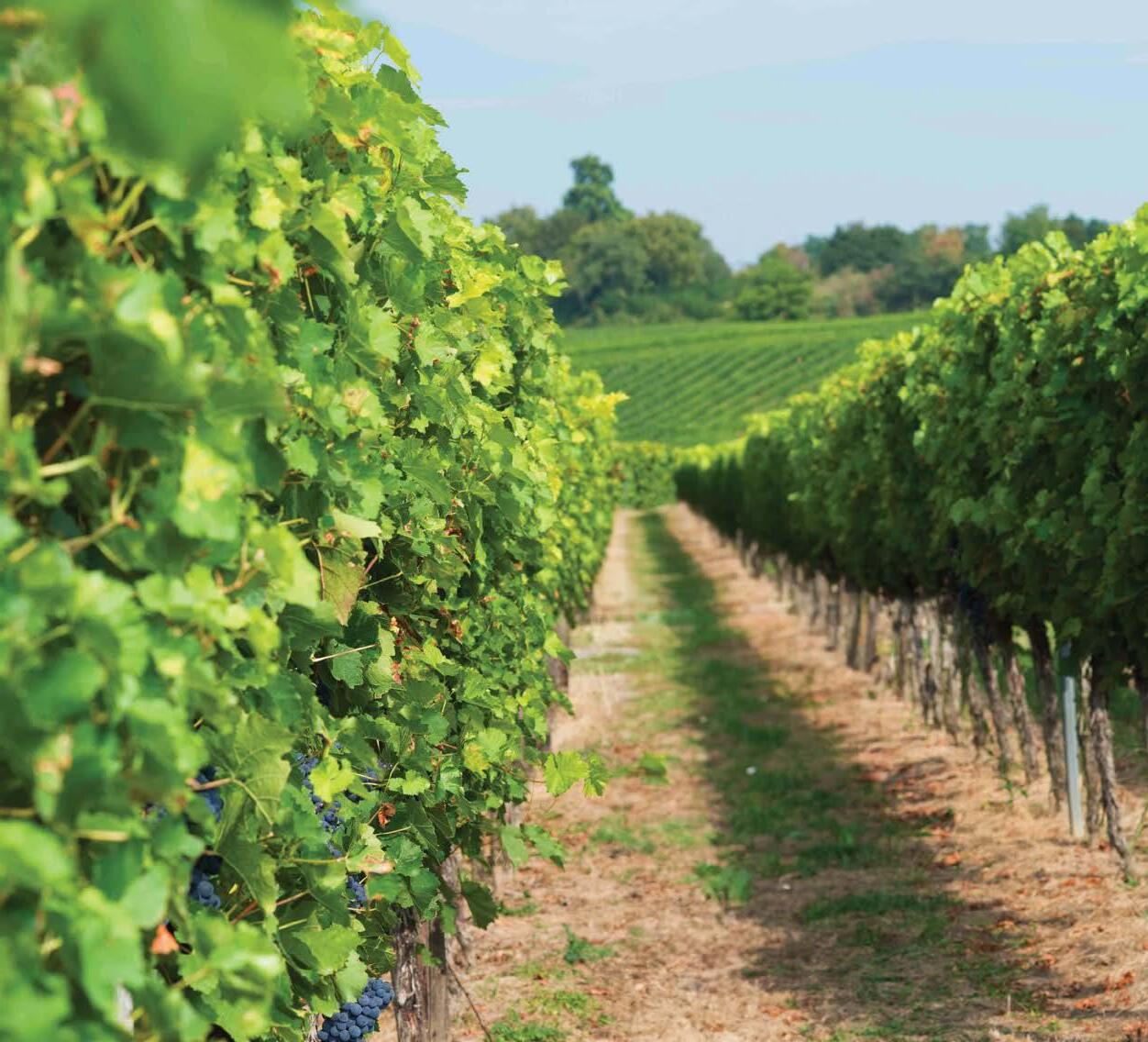
Our portfolio of powerful, proven products has helped growers from one end of New Zealand to the other create and maintain thriving businesses, and has earned us an excellent reputation in horticultural crop protection.
Our suite of insecticides and fungicides provide growers with everything they need in the war against pests and diseases.

Visit corteva.co.nz to view our range of products and online horticultural resources.
Samuel Whitelock – Plant Science Graduate, Lincoln University.

OPINION
THOUGHT LEADERS
WHAT THE HELL IS REGENERATIVE AGRICULTURE ANYWAY?
When NZGrower & Orchardist asked DIANA MATHERS to write three articles on regenerative agriculture, a journey of discovery began. Over the last four months she has dived into the literature and talked to growers, learning that many regenerative practices are already in place but they might not be thought of in that way.
I have spent my whole career working with growers and farmers in various roles; research and procurement for Wattie’s, project advisor for MAF’s Sustainable Farm and latterly as research manager for the environment at the Foundation for Arable Research (FAR).
In all these roles there was a focus on working with farmers to develop practical good management practices for their farm management. My efforts at FAR were focused on farm environment planning processes and keeping an eye on the environmental impacts of the farm system: Soil quality, nitrogen losses, beneficial insects and biodiversity on farms.
Regenerative agriculture was not mentioned – it hadn’t come into vogue yet – but the work we did has provided proven building blocks to support regenerative systems. Over the last few months, I’ve spoken with experts, read widely and visited vegetable growers like Hugh Ritchie and Gordon McPhail (see NZGrower & Orchardist September 2025) and for perennial crops Richard Mills from Summerfruit NZ and young regenerative kiwifruit grower Levi Belcher (see NZGrower & Orchardist October 2025).
Cover crops at LeaderBrand’s covered farming production facility
My journey into the realm of regenerative agriculture has caused me to stop and think about linkages between the farm, the supermarket shelves, my expectations and impact.
I don’t often think about where my food comes from. I’m probably no different from most consumers; food needs to be cheap and on the shelves.
This week my supermarket trolley was loaded with greens, kiwifruit and dairy products (from here I think), meat (possibly not from here), a courgette probably from Queensland, condensed milk from the Netherlands, crackers from Canada, and coffee, tea and rice all from somewhere else.
I pulled up short and considered this madness and the real cost. My expectations of having safe to eat, clean and nicely packaged food, always available, poses some fundamental questions about sensibility and impact.
You don’t have to search far to learn about the state of the planet and many are at a loss as to what can and should be done, so we stick our heads back in the sand, waiting for magic bullets to stop a downwards spiral.
In our privileged society the global production, processing and movement of food is a given. But how often do we consider the farmers, the farms and the environmental and social costs? Could regenerative agriculture have a part to play in reversing the downwards spiral?
Farm systems are dynamic, responding to the push for more production and the need to be profitable. Pull comes from opportunities for efficiency from larger machinery, robotics, better pesticides and herbicides and genetic modifications. Push could be regulatory and unpopular and sometimes there’s just a strong need to leave the farm “better than it was”.
The explosion of the term ‘regenerative agriculture’ or ‘regen’ happened about 10 years ago. Suddenly it was the buzz phrase, getting attention from farmers, governments and the biggest food companies – all seeing it as a magic bullet for sustainable production, secure supply chains and emissions management. But the shot was fired before there was any agreed definition of what regenerative agriculture was, nor proof of what it meant – and did it even matter?
My father said “We must not call soil Dirt... Don’t they know soil is the foundation of all life on Earth?”
Regenerative agriculture system thinking began in the United States and the United Kingdom in the 1980s. Concerns were growing about the sustainability of farm soils and biodiversity losses associated with farming in farming and scientific communities.
Robert Rodale in the United States worked with farmers in the Mid-West in response to soil degradation and erosion. He led the changes in thinking about soil management and supported farmers to adopt reduced tillage and cover cropping to support their soils. He also challenged them to think about regenerating the farm’s ecosystem.
FEATURES:
Gear driven rotary orchard mower
Robust, durable design
No daily maintenance
Designed & manufactured in New Zealand

Robert’s experience was with organic systems. He began looking for a new term to promote the new concept of regeneration. He was “not expecting farmers to convert to an extreme organic system, but to find a way of talking about opportunities for environmental and social improvement and a means to promote step wise conversions into lower input systems. Something regenerative.”
The term ‘regen’ came and went over the decades and the definition remained loose.
A review by Wageningen University in 2020 found that people using the term ‘regenerative agriculture’ were using different principles to guide regenerative agriculture efforts.
Despite the loose definition of regen, it has become ‘a thing’ for the world’s major food producers. For example, in 2021:
• PepsiCo announced that by 2030 it would work with the farmers in its supply chain to establish regenerative agriculture practices across their approximately 7 million acres (a goal PepsiCo extended to 10 million acres in 2025).
They have a pragmatic approach, saying: “Regenerative Agriculture is quite simple: it is any form of farming, i.e. the production of food or fibre, which at the same time improves the environment. This primarily means regenerating the soil. It’s a direction of travel, not an absolute.” The five principles they follow support resilient soil improvement.

• Unilever announced an extensive implementation plan to incorporate regenerative agriculture throughout their supply chain.
• Nestlé announced a Swiss franc 1.2 billion (NZD$2.6 billion) investment in regenerative agriculture by 2025, supporting their vision to reduce their emissions by 95 percent.
Optimistically I hope that this investment will define proven regenerative practices and proactively support farmers to transition to systems with proven benefits for the land, themselves and their communities. There is a risk of market coercion with no proven environmental gains or profitable benefits for the farmers.
In the United Kingdom, the Groundswell Festival is an annual event providing a forum for farmers, growers, or anyone interested in food production and the environment to learn about the theory and practical applications of regenerative farming systems.
Where does this lead New Zealand’s
Since 2020, there has been a flurry of activity within the scientific and government communities to gather information about regenerative farming and opportunities for pastoral, arable and horticultural farmers. They concur that regen is gaining momentum internationally and is set to become a significant trend. There is still no clear definition of what it is and it’s still in its infancy but gathering momentum.
On the ground, Quorum Sense is a community of farmers, growers, researchers, coaches and others committed to the creation of thriving biological and regenerative farm systems. They provide opportunities to learn from those who are giving it a go.
The Ministry for Primary Industries (MPI) has funded a number of sector-led projects on regen. These have seen scientists, industry and farmers working together, to develop robust and practical information. MPI has said they will not regulate regenerative practices. Their chief science adviser, John Roche says, “the choice is with farmers and growers, rather than those of us that think we know things, telling them what they should do.”
This places fruit and vegetable growers in a strong position. Investment in good management practices already supports sustainable and profitable production –the step to these being regenerative is within reach.
Growers turned out to hear Montana-based regenerative systems expert Nicole Masters speak at a soil health workshop held at Whitehall Orchards in Waikato recently
The sector groups have a part to play in supporting grower forums, learning from one another. When they work well, regenerative relationships provide linkages up and down the supply chain, from the soil microbiome, the plant roots and the crop, the farmed ecosystem and its biodiversity, the growers, food buyers and processors, intermediaries in the supply chain and lastly or firstly depending on the viewpoint, the consumer.
I hope that this investment ... will proactively support farmers to transition to systems with proven benefits for the land, themselves and their communities
Systems that are regenerative are not just sustainable; the expectation is they do more. Environmental change is slow and, in the interim, there are risks of cost to farmers, in dollars and time, and disheartenment.
There doesn’t need to be a cost or a fanfare.
But, there does need to be support from the market, the community and the individual consumer with acceptance that change takes time.
My father said “We must not call soil Dirt. That’s the stuff behind small boys’ ears. Don’t they know soil is the foundation of all life on Earth?”
I’m inclined to agree, and I think that’s where New Zealand’s opportunity sits for regenerative horticulture for cropping and permanent crops. We can define what it means for us focusing on adding value and resilience.
Let’s use regenerative processes to make our soils better and more resilient than they were.
Let’s protect our beneficial insects. And let’s also draw on all the accumulated knowledge we have invested in and support each other to learn and change.
I’ve learned that farmers are individualistic, innovative, resilient and well-aware of their soils, their farms and the surrounding environment. By drawing on proven information and farmers’ skills we can lead New Zealand into a regenerative future. We can define our own systems.
FROM STRESS TO SUCCESS
Help Your Vegetable & Fruit Crops
Megafol is a natural anti-stress and growth activator biostimulant. It is scientifically proven to help vegetable and fruit crops deal with a wide range of environmental stresses - like cold, heat, wet feet, hail and droughtwhile promoting balanced vegetative and reproductive
When Megafol is applied, the plant genes responsible for preparing or reacting to environmental stresses are activated. It also aids in plant recovery.
Available in 10L, 200L, 1000L.

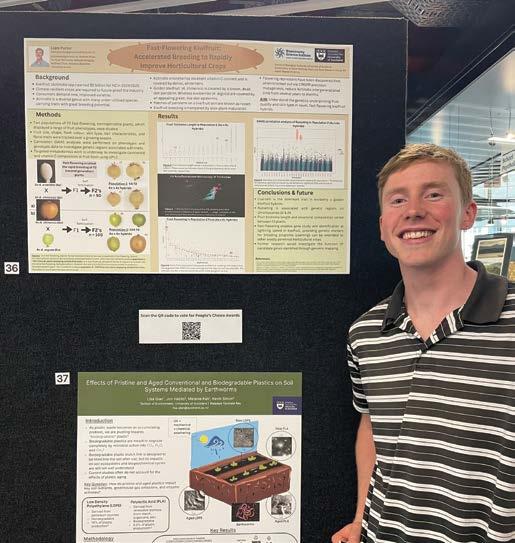
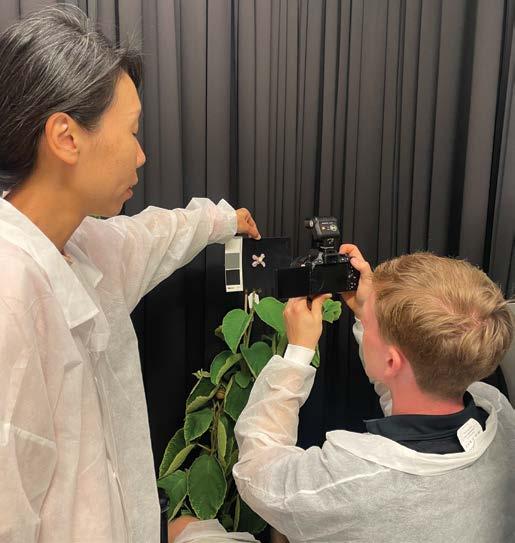
SCHOLARSHIP MAKES A REAL DIFFERENCE
Liam Porter’s Master’s research offers exciting potential for the kiwifruit sector and he’s glad that a horticulture postgraduate scholarship is enabling him to really focus on that.
Liam, aged 23, is in the second year of his Master of Science (MSc) with the University of Auckland, studying fruit quality attributes in novel kiwifruit hybrids.
His primary focus is investigating a hybrid cross between kiwiberries and golden kiwifruit with the aim of producing a fruit with even more health-associated compounds, including higher levels of Vitamin A, Vitamin C and other antioxidants.
Liam, who also works part time as a teaching assistant at the university, says being awarded the 2025 NZ Fruitgrowers’ Charitable Trust Postgraduate Scholarship has made a real difference for him.
Having studied for his Bachelor of Science (BSc) in biochemistry and biological sciences closer to home at the University of Canterbury, he was facing a lot of additional living expenses after moving to Auckland.
The scholarship, worth $10,000, is for postgraduate students undertaking study specifically related to the fruit industry.
“When I saw the criteria for the scholarship I realised it was very close to the proposal I had written for my research.
“It has been really good for me this year. It has given me confidence that I can put as much time into my research and devote as much time to my studies as possible.
Displaying research at joint-graduate school postgraduate poster competition at the University of Auckland
Imaging hybrid kiwifruit flowers to investigate the genetics behind anthocyanin production (which causes a pink/red pigment)
“The other really valuable part of the scholarship was that it included enabling me to attend the Horticulture Conference this year.
“That was a really interesting and exciting experience, learning more about horticulture from supermarket chains through to the consumer and growers and how they are integrating pest management, and everything in between.
“I also got to meet a lot of really interesting people from the sector. You can get a bit pigeon-holed in science so it was really interesting to get that broader context of horticulture.”
It has given me confidence that I can put as much time into my research and devote as much time to my studies as possible
Liam grew up as a “city kid, who had a bit of contact with farming through relatives” but was always fascinated by science and living systems.

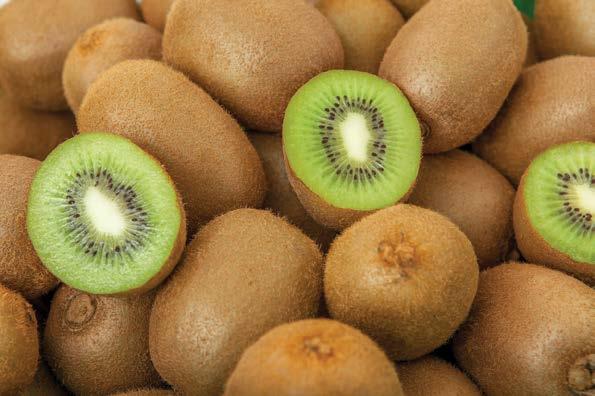

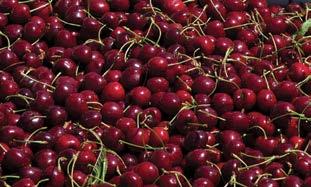

Having gained his BSc, he was keen to get more technical knowledge in the field and see where his interests really lay before pursuing further studies, so joined Canterburybased Leaft Foods as a process operator.
You can get a bit pigeon-holed in science so it was really interesting to get that broader context of horticulture
The company is focused on producing human edible products from rubisco, the protein in green leaves responsible for photosynthesis, including protein powders sourced from water lentils and alfalfa.
“The company was looking to work with growers growing winter crops for cows and plant their crops, like lucerne, which are also nitrogen fixers, in the off season, providing more value from the land,” says Liam.
“I worked there for a year before starting my MSc and it really sparked my interest in sustainable food systems
HORTICULTURE POSTGRADUATE SCHOLARSHIPS
Every year HortNZ and the NZ Fruitgrowers’ Charitable Trust each offer one scholarship for postgraduate study in New Zealand in horticulture or a related field (specifically related to the fruit industry for the trust).
Each scholarship provides $10,000 to support students undertaking postgraduate study focused on innovation and tackling challenges critical to the horticulture industry's future success.
Applications for the 2026 academic year close 1 December 2025.
Visit hortnz.co.nz for details or email questions to schols@hortnz.co.nz
and how we can produce food that is healthy and sustainable. At that time, they were an early startup but now they have product on the market.
“Kiwifruit is obviously a massive export market, and while there are quite a few varieties, there is always a desire for new cultivars and improvements in nutrition.”
Kiwifruit normally take three to five years to mature and produce fruit so, in order to be able to complete his research in a two-year timeframe, Liam is working, under the strictest biosecurity conditions, with GE cultivars which are modified to mature more rapidly.
“They are in a PC2 glasshouse, and the flowering repressor has been knocked out, so they produce flowers and fruit within as little as four to six months from germination, which is enabling me to undertake the research in my timeframe.
“I’m thoroughly enjoying it. I’m really interested in New Zealand food production and horticulture in particular and that’s where I see my future. I have just got a place on the Ministry for Primary Industries graduate programme, so my next step will be moving to Wellington for that.”
Imaging the vine architecture of a fast-flowering kiwiberry hybrid
MAXIMISING CROP RESILIENCE: THE MEGAFOL™ ADVANTAGE
In today’s challenging agricultural landscape, growers face unpredictable weather patterns and environmental stresses that can significantly impact crop yields. While we cannot control the weather, we can better prepare our crops to handle these challenges.
This is where MEGAFOL™, a proven biostimulant, has been making a remarkable difference in crop management strategies worldwide.
MEGAFOL™ isn’t just another input – it’s a sophisticated stress-management tool backed by over 25 years of commercial success and extensive scientific research.
What sets MEGAFOL™ apart is its unique formulation of bioactive compounds, including specific plant-derived metabolites, peptides, amino acids and other crucial molecules that work together to enhance crop resilience.
this breakthrough technology exceeds simple nutrient supplementation. Each batch undergoes stringent quality analysis, ensuring precise, consistent performance. By activating the inherent defence mechanisms of the plants at the molecular level, MEGAFOL™ empowers crops to combat stress more effectively.
What sets MEGAFOL™ apart is its unique formulation of bioactive compounds
For growers looking to optimise their crop management strategy, MEGAFOL™ offers a proactive approach to stress management. Whether it’s dealing with late frost in orchards, heat stress in vegetables, or recovery from chemical application, having MEGAFOL™ in your toolkit provides valuable insurance against yield loss.
The return on investment is clear: reduced crop losses, improved quality and more consistent yields across challenging seasons. In an era where weather extremes are becoming the norm rather than the exception, tools like MEGAFOL™ aren’t just helpful – they are becoming important for sustainable farm management.

As we look to the future of agriculture, the role of biostimulants like MEGAFOL™ will only grow in importance. With increasing pressure to produce more with less environmental impact, solutions that enhance natural plant resilience while supporting sustainable practices are invaluable.
Scientific literature confirms that abiotic stress causes about 70 percent yield reduction, while many crops do not reach 20 percent of their production potential due to abiotic stress (Source: FAOSTATS 2013 and Baray et al, 2002).
Results have been impressive with growers reporting faster crop recovery after frost events, improved drought tolerance and better bounce-back after herbicide stress.
But what really matters is how it works in the field. When applied preventatively before stress events or as a recovery treatment, MEGAFOL™ triggers rapid responses in plants. Within hours of application, it activates over 127 stressresponse genes, leading to improved photosynthetic efficiency, better stomatal conductance and stronger cell membrane stability. This translates to visible results: greener leaves, better root development and ultimately, more resilient crops.
The science behind MEGAFOL™ is impressive. Engineered through VALAGRO’s sophisticated GEAPOWER™ platform,
In an industry where every season brings new challenges, MEGAFOL™ stands out as a proven solution for building crop resilience and protecting yield potential. It’s not just about surviving stress – it’s about giving your crops the best chance to thrive despite it.
Backed by extensive New Zealand field trials and research, MEGAFOL™ is a premium, reliable stress-management solution.
If you are interested in learning more, connect with one of the dedicated Agritrade VALAGRO team:
Upper North Island, Tamzin Lee – 027 255 4615
Lower North Island, Mike Hope – 027 531 3455
All South Island, Nic Peters – 027 534 4662
Article supplied by Agritrade © 2025. MEGAFOL™ is a registered trademark of a Syngenta Group Company.
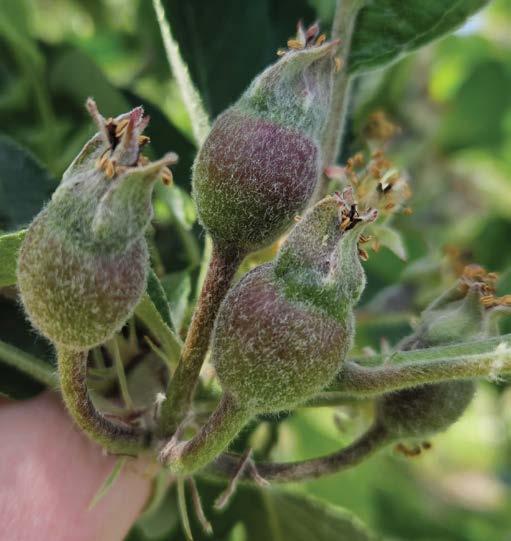

CROPLOADING – OPTIMISING CARBOHYDRATES TO MAXIMISE CROP POTENTIAL
Carbohydrate efficiency is the driver behind fruit quality, fruit size, vigour management and overall plant health. Carbohydrates are responsible for maintaining tree function (e.g. respiration, translocation and bud development), as well as fruit development (e.g. size, texture and flavour).
Meg Becker : AgFirst Consultants Hawke’s Bay
Maximising photosynthesis, the translocation of carbohydrates from the leaf to developing fruitlets and reducing environmental and/ or physiological stresses on the plant all aid in optimising the overall plant function and fruit quality.
Getting the cropload to target quickly provides numerous benefits. These include driving plant carbohydrate efficiencies, and therefore fruit quality and consistency, as well as influencing return bloom for the following season’s crop.
As a result, all early techniques to ensure reserves, and that carbohydrate production is portioned into fruit we intend on putting in the bin at harvest is key. Remember that fruit is a carbohydrate sink, meaning it draws on energy produced by the plant. Therefore, the higher the cropload, the further the carbohydrate needs to be spread.
Fruit cropping capabilities are specific to the crop type, cultivar, seasonal attributes and most importantly, block specific characteristics. The first standpoint to ensure carbohydrates are utilised efficiently is to set an accurate, achievable fruit target.
Figure 1 a : Apple fruitlets going through cell division
b : Fruitlets in the cell expansion phase (waxy cuticle has developed)
This should initially be done in the winter, prior to winter pruning. The targets should then be ‘tweaked’ at each critical stage during the season to ensure they are still practical and achievable – e.g. review targets after pruning, and before hand thinning.
Failure to set and achieve these targets could lead to compromised size, reduced fruit quality and potential challenges with maturity and colouring at harvest. Understand your block specific limitations to cropping and farm to these.
Steps to confirm winter cropload targets include:
p1
Determine what the optimum yield potential for your crop type or cultivar would be on the ‘perfect canopy’.
2 Block specific canopy fill: Make an accurate assessment.
3 Fruit size profitability sweet spot: If you adjust your size profile, adjust the target to match!
4 Account for pick-out based on this season’s fruit quality characteristics.
5 Set realistic pack-outs.
In many crop types there is a multi-pronged approach taken when it comes to thinning, with cropload reduction beginning during winter pruning (the most cost-efficient time to thin a tree). Detailed removal of spur/bud pruning allows for high carbohydrate efficiencies in the spring by reducing floral load on the tree. Chemical thinning may also be an opportunity to reduce early season croploads, targeting cropload at both primary (flower) thinning and secondary (fruitlet) thinning. This provides gains in fruit size potential, by reducing cropload stress on the plant during the critical cell division phase.
The cell division period determines the total number of cells that will eventuate in a piece of fruit, ultimately predetermining the size potential for that fruit in any given season. Cell division in pipfruit extends up to 50 days post full bloom depending on varying factors including variety type and climatic conditions. A good gauge to determine when cell division ends, is once the waxy cuticle develops on the fruit. This is when the ‘fuzzy’ appearance on the skin of the apple disappears. During cell division, having high sunshine hours and a good diurnal variation (warm days and cool nights) will maximise the photosynthesis process and improve carbohydrate efficiency. Ensuring balanced soil moisture over this period is also critical to optimise carbohydrate translocation within the plant.
Cell expansion occurs from approximately 50 days post full bloom, right through until harvest. As already mentioned, the maximum potential fruit size has already been predetermined by this stage. Despite this, continued optimisation of carbohydrate efficiencies, photosynthesis, nutrition and overall plant function over cell expansion helps ensure the maximum potential size for each individual cell is achieved. This also helps to ensure consistent incremental gains in fruit size are being achieved each week. Monitoring fruit size diameter can be a quick measure to understand if the tree is coming under any physiological (or environmental) stressors which could result in compromised sizing.
Lowering
croploads quickly
and efficiently not only aids fruit quality and size outcomes but also supports return bloom
Generally, hand thinning occurs during this cell expansion phase, where the fruitlet is big enough to remove by hand practically and economically. At hand thinning make timecritical and practical decisions to manage labour efficiencies, optimise high returning varieties and manage croploads.
“This fascinating book takes us on a journey”
From the earliest days of New Zealand horticulture, through the 20th century and the burgeoning west Auckland domestic and export fruit trade. The politics. The personal and entertaining recollections of the families whose lives were dedicated to orcharding. Finally, to the inevitable pressure of development, and the disappearance of prime horticultural land under a swathe of new housing. It’s a story played out across all of Aotearoa, and a mustread for all rural New Zealanders. Beautifully illustrated it captures an era that is fading into history.
The perfect Christmas gift for the ‘hard to buy for’ family member or friend. Just $49 incl GST & postage.
Email orders now to: Huapai Kumeu Lions Club sales.hklions@gmail.com
All proceeds to service projects in the West Auckland community through the Lions Club Network
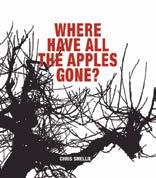



Prioritise blocks by their pre-thin croploads
Understand your tolerance to the target (min & max croploads for each block)
“Do it once, and do it right” A groom should be treated as such – this is not a second thin!

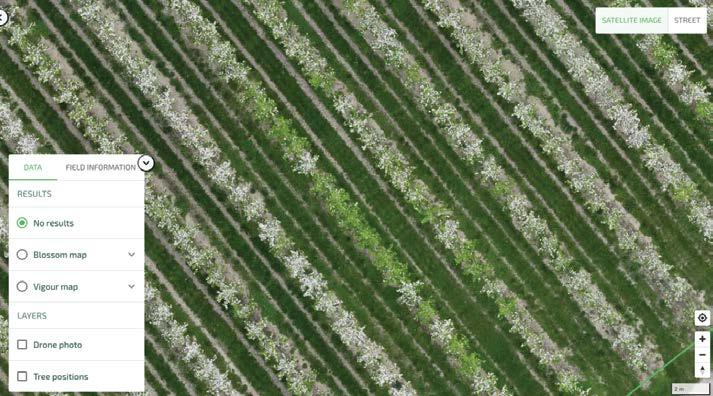


Figures 2 and 3 : Drone imagery used to map bloom density in a pipfruit block at full bloom – showing between tree biennial tendencies
2
3 Satellite image With blossom map overlay

Be sure to take a data driven approach throughout the thinning programme, to ensure targets are being achieved in real time. Pre-thin fruit counts or cluster counts should be used to determine if there are enough fruiting sites to achieve the set target, and which blocks are the highest percentage above the target requiring prioritisation. Both monitor and post thin fruit counts should be carried out to ensure the thinning stays on track. This will also show variances in cropload across the block. Keep in mind –it can be just as detrimental to fruit quality when fruit numbers are below target as it can to be above!
Often a groom thin (a pass to refine quality and consistency in cropload) may then be carried out in the new year. A mistake commonly made is where the groom becomes a second thin with heavier than optimum croploads carried through into the new year. This is inefficient and costly. A groom should never target any more than five percent of the crop, focused towards removing undersized, blemished or misshapen fruit which would otherwise lower pick-outs and pack-outs.
Lowering croploads quickly and efficiently not only aids fruit quality and size outcomes but also supports return bloom. Biennial bearing and challenges with return bloom are a significant issue influencing cropping capabilities and overall productive potential. Some crop types are more susceptible to this issue. Challenges with return bloom are most commonly related to croploading and thinning timing. Other factors influencing a poor return bloom can also include plant nutrition, and other tree stress factors.
Once a block goes biennial, careful management of trees is required in the ‘on’ years to support return bloom. Specifically in pipfruit strategic use of chemical thinners and the use of PGRs (plant growth regulators) supports this, for example Ethephon used as a primary thinner is known for its ability to support return bloom, aside from its ability to enable early cropload management (which in itself is beneficial).
A groom should never target any more than five percent of the crop, focused towards removing undersized, blemished or misshapen fruit
Even if unable to be seen visually in blocks, a biennial swing may be seen in harvested bin numbers and should be monitored closely each season. Early identification allows for early management.
Between tree biennial tendencies are generally brought on by trees that were over-cropped the season prior (as well as other potential factors such as tree stress, excessive vigour or challenges with shading). The ability to identify a ten percent variability in cropload by ‘eyeometer’ is incredibly tricky, however consistency is essential when trying to farm to excellence.
Targeting (flower) thinning may also be an opportunity to reduce early season croploads
TECHNOLOGY OPPORTUNITIES
Fruit scanning and heat mapping with:
Camera scanners (eg on tractors) and drone cameras
Pairing with GPS and satellite imagery
Pairing with variable-rate sprayers
This requires continued data collection, counting representative areas and comparing counts against the targets that have been set. What is your margin of tolerance, and are your counts within it?
In highly variable blocks, tagging trees in their ‘off’ year means that croploads can be managed carefully the next season. The most efficient way of managing this specific scenario is over winter pruning – putting more effort into spur/bud pruning ‘on’ trees. At thinning it is best to thin these variable blocks early in the season, and managers may also choose to revisit these biennial blocks post thinning to solely target these ‘on’ higher cropped trees, to ensure fruit numbers are within the margin of tolerance that has been set.
With camera technology becoming more readily available on the commercial market, fruit scanning and ‘heat mapping’ croploads post thinning can allow for faster and more representative quantification of fruit numbers. Although these counts need to be groundtruthed, this technology allows for more accurate management of heavy or variably cropped areas. Drone scanning can also be used to detect between tree variability at flowering, providing exciting management opportunities such as pairing GPS (global positioning systems) technology, and well-timed scanning with variable rate sprayers at chemical thinning to target specific areas based on floral capacity.
In order to manage vigour where there are limited fruit sites it can be tempting to carry doubles to make up croploads, however despite the presence of resting sites, this can lead to within tree biennial bearing. It can be hard to see a cropload tolerance of 10 percent at a tree level, let alone on an individual branch where the margin for tolerance is even tighter. When this happens, the fruit will struggle to ripen and colour correctly.
Other than cropload and management of seasonal variability there are other in season management strategies that can aid in the prevention of biennial bearing, as floral bud initiation for next year’s crop occurs during the growing season.
Optimising croploads as early in the season as possible is key to optimising fruit quality, size, and long-term orchard productivity
If you have been noticing a biennial swing in your pipfruit blocks, a summer NAA (Naphthalene acetic acid) programme can support return bloom following an ‘on’ year. NAA is a synthetic auxin, the plant growth regulator required in high concentrations to initiate flower development. When determining application timing, it is important to understand when your cultivar is initiating floral buds for the next season. Floral bud development can occur anywhere from one to three months after full bloom, when the plant develops auxiliary buds. Check the label however, as some varieties are susceptible to pygmy fruit with the application of NAA.
A summer girdle may also be used to increase return bloom. This is a narrow cut placed in the trunk of the tree or vine. The cut goes through the phloem and cambium reducing sap flow through the plant, preventing the flow of carbohydrates back to the roots and therefore improving carbohydrate efficiencies within the plant. This technique has the added benefit of improving dry matter and enhancing fruit quality. Girdling does however, influence fruit maturity, so maturity monitoring and close harvest management will be key to ensuring the fruit comes off on time, and in specification.
Online Orchard Irrigation Supplies
Call our experts 0800 130 905 www.irrigationexpress.co.nz
Optimising croploads as early in the season as possible is key to optimising fruit quality, size, and long-term orchard productivity (return bloom). Setting and achieving the correct croploads at a block (and tree) specific level ensures that carbohydrates are partitioned into the highest quality fruit, which will ultimately end up in the bin at harvest!
CONTROL FRUIT RIPENING WITH PRECESION — HARVISTA™ 1.3
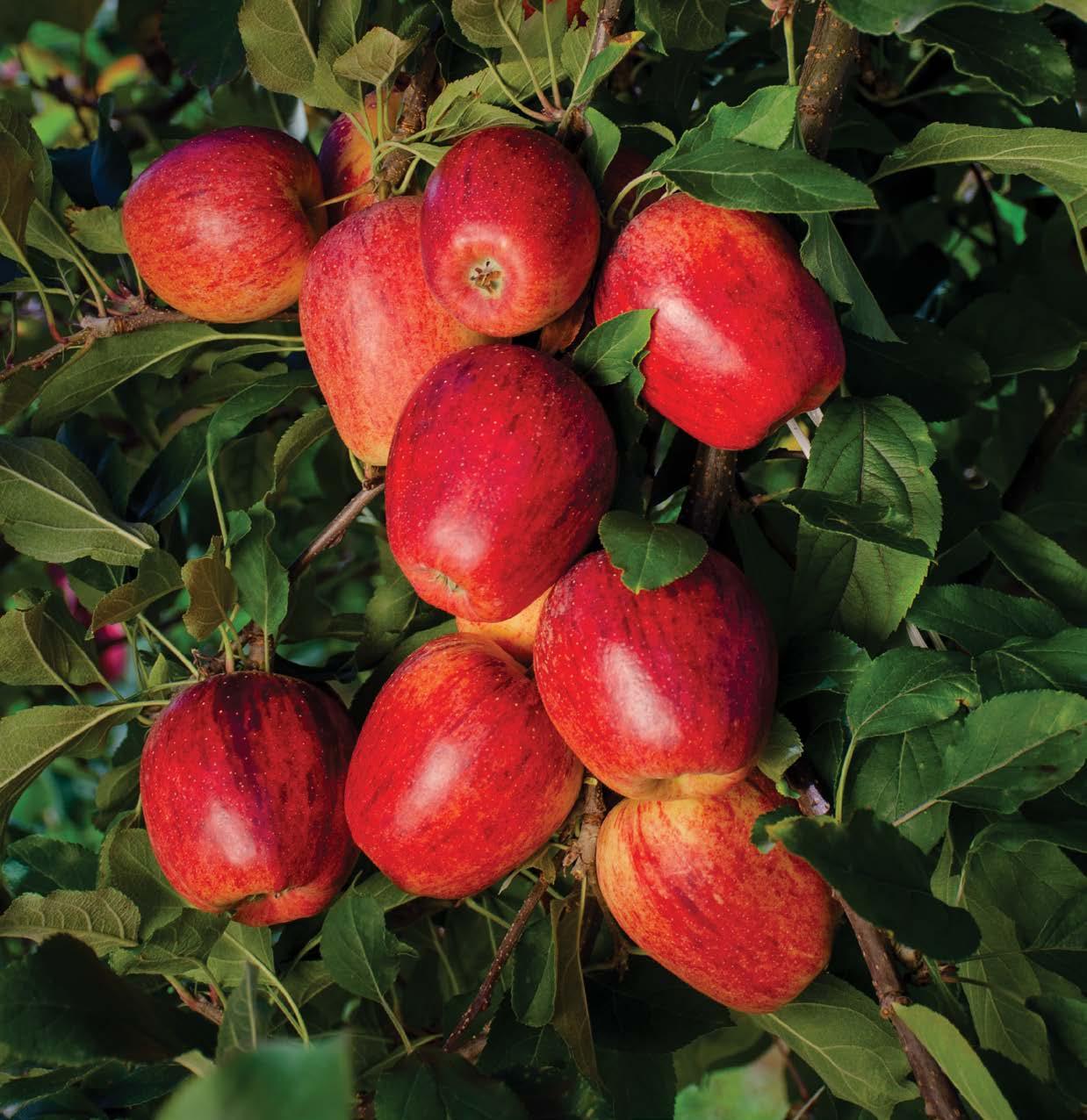

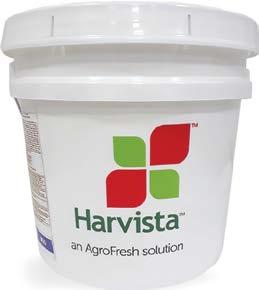
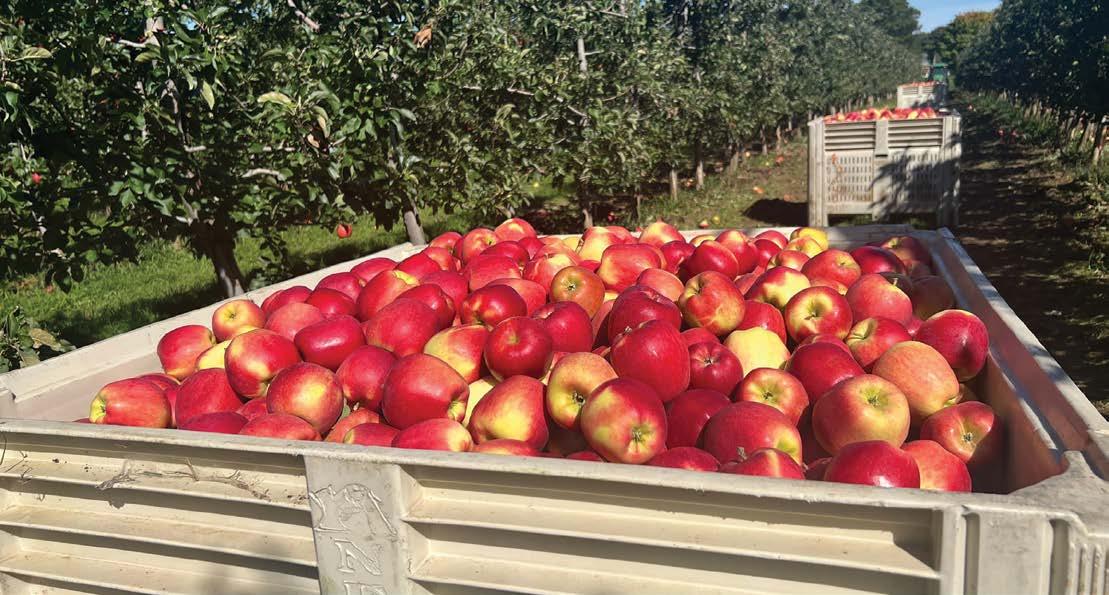


Watch Kenny Lau’s presentation at the Horticulture Conference 2025 on HortNZ’s YouTube channel https://www.youtube.com/watch?v=Q5YU-_l-7EM
CAPITAL FROM OVERSEAS
New Zealand’s current low dollar is not only great for export revenue, but also for importing capital – which is in short supply domestically. The autonomous Crown entity InvestNZ was established in July to attract international investment. We got some advice from KENNY LAU, an investment manager at InvestNZ who also spoke at this year’s Horticulture Conference.
Are overseas investors interested in New Zealand horticulture?
“We’ve seen corporate investors like Baywa AG, Joy Wing Mau, China Resources (previously an investor in Scales), FS Investors from America, and we are yet to see more of these professional investments into horticulture in New Zealand.
“On the other hand, investments from High Net Worth Individuals are quite common in New Zealand, like in a Limited Partnership, but they are mostly domestic investors.
“However, increasingly the key export crops are attracting foreign direct investment. Asian investors are a very important source of investment for New Zealand. Horticulture’s key export markets are in Asia, and that aligns with those investors’ interests.
“They usually come in and invest for a reason other than just a financial return on investment, because they want to secure supply. For example, a corporate may already be operating a distribution business themselves or dealing with network for other products in their market.”
What sorts of horticulture businesses attract overseas investors?
“Investors will want to see a tidy company structure, a good reporting system, and strong governance, as well as financial forecasts that indicate stability and/or growth.
“Generally professional or corporate investors like to see brownfield investments (existing developments) more than greenfield (yet to be developed). And mostly they will want to invest in a business with a company structure rather than a Limited Partnership. Most of our investments in horticulture are set up as Limited Partnerships, so there is a gap there that I think is worth us thinking about.
“InvestNZ can discuss and provide guidance to company owners about preparing for investment and the transaction structure relevant to the investment. The size and scale of the investment as well as the type of investor will determine the requirements.”
Is horticulture interesting for migrant investors?
“The Active Investor Plus (AIP) visa incentivises high value, migrant investors to invest directly into New Zealand businesses seeking growth capital. Generally, AIP migrant investors are not looking to take over a business operationally, they are looking to invest into a business.
Migrants can invest into horticulture as a qualified investment
“Starting from April this year, the AIP policy includes horticulture as an acceptable investment, which was not the case before. That means migrants can invest into horticulture as a qualified investment to get a resident visa. It’s a very important move.”
The Government is reforming overseas investment regulations, but will this encourage investment in horticulture?
“The Overseas Investment Act (OIA) is still the single largest hurdle for foreign investors if they will own 25 percent or more of your business. The overseas investor and the investee company will need to seek direct advice from specialist OIA legal advisors before entering into a transaction that may trigger an Overseas Investment Office (OIO) application. InvestNZ can suggest legal advisers if they are needed. Note that it is the overseas investor that makes the application to OIO if required.
“InvestNZ can explore any potential OIA hurdles with the overseas investor and the investee company when they are in early discussions. Parties can also request a preapplication meeting with the OIO to ask questions.”
Does foreign direct investment mean giving up ownership for middle-market and family-run businesses?
“I think that it is a sensitive but important issue for anyone seeking capital. Are you ready to share control of your business with foreign investors?
“Have you spoken with your bank and exhausted lending first? Because that’s the cheapest capital. Every time you come to equity (i.e. investor capital), that’s more expensive.”
Are investors only interested in kiwifruit, apples and cherries?
“We have emerging crops with great growth potential, like hops. For some years New Zealand aroma hops have built an international reputation across craft beer industries.
“But more than that, I’ve been working with investors on extracting ingredients from hops for weight management nutraceuticals, as in GLP-1 appetite control supplements.
“There is also increasing demand for traceable, highintegrity seeds globally. Biosecurity concerns drive preference for New Zealand-grown seed.
“Blueberries are another emerging crop, with strong demand for antioxidant-rich and functional foods, especially in Asia-Pacific.
“We are seeing some innovative examples of rotational crops such as oats and alfalfa being used in plant-based milk and alt protein extraction, or extracting fibre of Harakeke (New Zealand Flax) into making new composite materials. These illustrate alternative ways of increasing the commercial return of traditional low/no return crops





NEW ZEALAND ONION DELEGATION STRENGTHENS TIES WITH INDONESIA
Kazi Talaska : Onions New Zealand general manager
A delegation representing New Zealand’s onion industry has completed a successful visit to Indonesia, aimed at deepening trade relationships, exploring new market opportunities and strengthening agricultural cooperation between the two countries. The three-day visit in July brought together representatives from Onions New Zealand, New Zealand onion growers and exporters, and government officials from both nations. Onions New Zealand general manager Kazi Talaska says the visit continues a long-standing partnership built on trust, shared knowledge and mutual benefit.
Indonesia: A key partner in Southeast Asia Indonesia is the single largest market for New Zealand onions in Southeast Asia. New Zealand onion exporters have developed strong partnerships over more than a decade with Indonesian importers, supported by steady trade growth under the ASEAN-AustraliaNew Zealand Free Trade Agreement (AANZFTA).
The local growers were very appreciative that our growers made the effort to go over and see them
New Zealand onions are primarily sold into Indonesia’s wholesale and rapidly expanding food service sectors, meeting demand across a diverse range of cuisines. The strong reputation of New Zealand onions for quality, safety, and consistency continues to underpin their success in this dynamic market.
The Allium Cooperation Project

Recognising that trade is a two-way relationship, the New Zealand onion sector has invested in ongoing cooperation and relationship-building projects over the past three years with the Indonesian Ministry of Agriculture.
One such initiative is the Allium Cooperation Project, signed in June 2023 through the Ministry’s Bureau for International Cooperation. The project, now coordinated by the Agency for Agricultural Development and Modernisation, focuses on knowledge exchange and practical collaboration between New Zealand and Indonesian allium growers.
“The cooperation project aims to implement verified, standardised shallot cultivation methods that not only increase productivity but also ensure food safety and environmental sustainability,” Kazi says.
“Joint knowledge sharing between New Zealand and Indonesian growers has been central to the project’s success, particularly in managing soil-borne diseases such as Fusarium.”
As part of the visit, the delegation toured two sites: the cooperation project’s demonstration plots showcasing new allium varieties, and a local shallot farm – one of more than 600 benefiting from the programme’s outreach and technical support.
This was the first time New Zealand growers had been to the project. Grower Chris Nicholson from Hinemoa Quality Producers Ltd near Pukekohe joined the delegation – his first work-related trip to Indonesia.
“The local growers were very appreciative that our growers made the effort to go over and see them.”

Chris says visiting the local farms was eyeopening. “The growing conditions are totally different. There is a lot of development needed there. I gave them a programme to look at from our agronomist, but it’s pretty clear that they still have a long way to go.”
Joint knowledge sharing between New Zealand and Indonesian growers has been central to the project’s success
Annually, the cooperation agreement sees approximately NZD $20,000 – $30,000 of investment that supports research on site, development of extension materials, variety trials, grower webinars and an extension outreach programme for over 600 growers.
Strengthening trade and biosecurity
The delegation also visited the Indonesian Quarantine Authority at Tanjung Priok Port in Jakarta to learn more about import processes and explore ways to streamline future shipments. New Zealand onions are now exported under a new phytosanitary protocol with Indonesia, ensuring products continue to arrive in top condition and free from pests and diseases of concern.
Michael Croft, general manager at HarvestFresh, has been exporting into Southeast Asia for 20 years. Although he is regularly in Indonesia, he says joining the delegation was an opportunity to learn and build new relationships.
“I’m usually just dealing with importers, so this trip provided a fresh perspective and a clearer understanding of port processing and clearing produce,” Michael says. “It was also good teambuilding with a well-balanced mix of exporters and growers participating. It was well organised and it’s a real bonus having Kazi there speaking the lingo.”
The Indonesia delegation of Onions New Zealand representatives, growers and exporters with local farmers and Ministry of Agriculture staff


He says while exporting into Indonesia is a huge opportunity for New Zealand onions, it comes with its fair share of challenges each year.
“We’d like some stability but it’s not just an issue for New Zealand onions. It’s across the board, so trying to influence that is quite difficult. Cementing relationships and building cooperation with both quarantine officials and government is definitely a step in the right direction.”
insight into how onions move through the local supply chain – from arrival and storage to repacking and sale.
Looking ahead
$20,000–$30,000 NZD OF INVESTMENT SUPPORTS RESEARCH ON SITE, DEVELOPMENT OF EXTENSION MATERIALS, VARIETY TRIALS, GROWER WEBINARS AND AN EXTENSION OUTREACH PROGRAMME FOR OVER
Meetings were also held with the New Zealand Embassy in Jakarta, local importer associations, and retail and wholesale operators. Visits to major supermarkets and one of Jakarta’s largest wholesale markets provided valuable first-hand
600 GROWERS
Southeast Asia remains one of the highest-value export regions on New Zealand’s doorstep – an opportunity well worth ongoing investment from the country’s horticultural industries.
The New Zealand onion sector continues to develop a work plan focused on supporting trade and technical cooperation with Indonesia. The delegation’s visit underscores New Zealand’s commitment to building resilient, sustainable, and mutually beneficial agricultural trade relationships across Southeast Asia.
Onion grower Chris Nicholson spoke at a research sharing session
Onions New Zealand general manager Kazi Talaska with head of the research cooperation project Dr Eti Heni Krestini

ALLIUM COOPERATION PROJECT
Since 2023, the Allium Cooperation Project has focused on knowledge exchange and practical collaboration between New Zealand and Indonesian allium growers. Deliverables achieved to date include:
A grower survey to identify key challenges faced by allium producers
Variety trials for onions and shallots
Demonstration webinars and training sessions
Field demonstration plots and grower trials, and Crop husbandry and best-practice guidance materials.
New Zealand onion exports to Indonesia (tonnes)
INDONESIA
Population: More than 280 million people (the world’s fourth-most populous country)
Trade agreement: Indonesia and New Zealand are part of the ASEAN-Australia-New Zealand Free Trade Area (AANZFTA), which entered force in 2010 (an upgrade entered force in April this year)
Onion exports:
• Onions are New Zealand’s largest crop export to Indonesia
• Indonesia is New Zealand’s second largest export destination for onions
Onion exporters are hoping to see more stability in trade with Indonesia. Data source: Stats NZ

COMMON GROUND – REFLECTIONS FROM WORLD FOOD INDIA
New Zealand’s attendance at World Food India last month was a milestone in the ongoing trade negotiations between our two nations. As a group, New Zealand Inc showcased our expertise in food innovation, production, processing and safety, our delicious produce itself and crucially, our manaakitanga to all who visited us.
Karen Morrish : NZ Apples & Pears Incorporated chief executive
It was an incredibly special event to be a part of, and one where the value will continue to deliver for some time to come.
However, to NZ Apple & Pears this most recent visit to India was so much more than this.
With collaboration between Aotearoa’s and India’s apple and pear industries stretching back to the 1990s, World Food India, and our subsequent visit to Himachal Pradesh, was a powerful reminder of the enduring and evolving partnership between our two nations.
In the 1990s, the World Bank Apple Industry Development Project first brought our growers
and researchers together. Since then, our goals remain aligned with both countries seeking to improve orchard gate returns, increase productivity and yields, and critically, ensure a sustainable industry is left for future generations.
Despite differences in scale, it was this shared vision that prevailed throughout our two weeks in India, with cooperation and collaboration paramount as we look to a future that includes a dynamic exchange of knowledge and innovation.
Four days at World Food India was a timely platform to explore these possibilities.
The New Zealand delegation visiting Stokes Orchard in Himachal Pradesh

NZ Apple & Pears market access manager Danielle Adsett and I joined New Zealand Trade and Enterprise, Bioeconomy Science Institute and other sector groups at the New Zealand Pavillion, where our Partner Country status gave us great profile and multiple touch points with the Indian Government, as well as meaningful interactions with a number of senior officials.
We also lent our voices to panel discussions throughout the day. Danielle spoke to Strengthening Food Safety Infrastructure in India: Integrating Policy, Accreditation, Laboratory Capacity and Technological Innovation, while I joined a panel on India as a Global Food Processing Hub: Boosting Compliance with Global Food Safety Standards respectively.
...this recent visit only further affirmed our belief that the future of horticulture lies in collaboration, not competition
Following the event, we were then joined by key sector experts as we travelled north to Himachal Pradesh and had the privilege of reconnecting with long-standing partners and forging new relationships.
Here we witnessed firsthand the energy and ambition driving India’s apple industry forward. We toured orchards and packhouses and met with officials spanning from
the Chief Minister to the Himachal Pradesh Government, Sukvinder Singh Sukhu, and Mayor of Shimla, Surinder Chauhan, in Himachal Pradesh, to Joint Secretary of the Minister for Agriculture and Workers Welfare with the Government of India, Priya Ranjan at his offices in Delhi.
Throughout these meetings, we were united by common values: Pride in our growers, a deep respect for the land, and a commitment to sustainable, future-focused horticulture.
India’s keen desire to transition from traditional low-density orchards to high-density, technology-enabled systems mirrors the journey New Zealand growers have undertaken over the past two decades. It’s a transformation that has delivered significant gains in productivity and profitability, and one we are eager to support India in achieving.
This visit to India was the third of its kind by the New Zealand apple and pear industry in the last 12 months, underscoring the growing momentum behind our bilateral horticultural partnership.
We have worked exceptionally closely with the incredible team at the Ministry of Foreign Affairs and Trade and the Ministry for Primary Industries, whose support has been vital in strengthening these ties. Earlier this year, we were also privileged to host a delegation from India’s Ministry of Commerce in Central Otago, where they toured local orchards and saw first-hand the advanced growing systems that are reshaping New Zealand’s apple sector.
NZ Apple & Pears’ Karen Morrish and Danielle Adsett speaking with Chirag Paswan, Minister of Food Processing Industries (in white) at the New Zealand Pavillion at World Food India
It is this expertise in orchard systems, alongside the cutting-edge work of New Zealand’s breeding and commercialisation companies such as Prevar and VentureFruit, that excites our counterparts in India. Grower to grower collaboration and knowledge sharing continues to be critical as India pursues its goal of becoming a global food basket and providing produce that meets the highest of global standards.
And this recent visit only further affirmed our belief that the future of horticulture lies in collaboration, not competition.
By working together, New Zealand and India can unlock new potential for growers, researchers and consumers alike.
As we look ahead, NZ Apples & Pears is committed to facilitating this knowledge exchange and deepening our engagement with India’s growers.
The conversations we had in Delhi and Himachal Pradesh are just the next step of what promises to be a mutually beneficial partnership, rooted in common ground and a passion for growing the best apples and pears in the world.
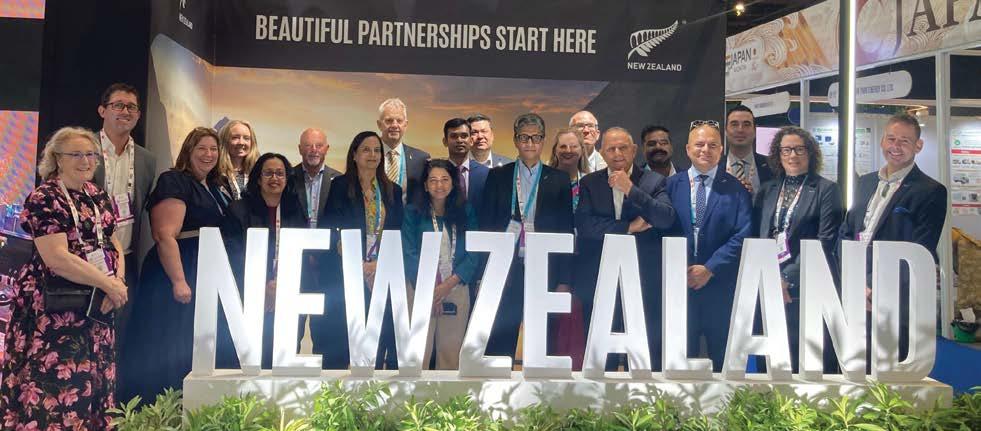
HORTICULTURE PROMINENT IN TRADE DELEGATION
New Zealand Trade and Enterprise’s (NZTE) delegation to India in September included horticulture industry bodies NZ Apples & Pears, Summerfruit NZ, NZ Avocado and NZ Blackcurrant Co-operative.
“Summerfruit is enjoying equal billing with apples, kiwifruit and other exports from New Zealand, which is great for our growers,” says Summerfruit NZ commercial manager Raj Singh, who joined this delegation and another horticulture trade delegation to India late last year. “We are also exploring tech transfer options although these discussions are in their infancy.”
India is an emerging but strategically important market for New Zealand’s avocado growers. NZ Avocado chief executive Brad Siebert was also part of the delegation and says a key objective was to actively engage with both New Zealand and Indian officials. NZ Avocado
wants to clearly demonstrate the avocado industry’s commitment to building a strong and enduring trade relationship with India.
Blackcurrants joined for the first time. Mike Callagher, general manager at NZ Blackcurrant Co-operative says blackcurrant is not widely known in India, although it is a popular ice cream flavour.
“Many thought they were Black Corinth grapes (seedless grapes from Greece) and took some convincing that they were not!”
Mike says that blackcurrant juice concentrate may not be sweet enough for local tastes and the IQF market is limited due to the markets and small shops where most fruit is sold fresh. However, he saw some potential in the convenient whole fruit powder format, which is increasingly popular.
The New Zealand Pavillion at World Food India

TOMATOESNZ UPDATE
Dinah Cohen : TomatoesNZ general manager
Grodan low input trial
A webinar for New Zealand growers was held last month where Andy Lee and Tico van Leeuwen, both from Grodan, presented the results of trials investigating if it is possible to further reduce heat (energy) input into a winter full LED crop in the Netherlands. The trials are now in their third year.
During the webinar we heard about the original objectives to reduce the energy input by 40 percent compared to reference growers, without having an adverse effect on the crop quality or yield. They achieved a 50 percent reduction in heat input using an active dehumidification system for humidity control. This allowed the vents and screens to remain closed for the majority of the winter lit-season.
Like the current situation in New Zealand, growers in the Netherlands are facing increasing energy prices which was exacerbated when the Russian – Ukraine war started. This led to agronomists at Grodan and research partners Philips Horticultural LED Solutions to challenge the commonly held belief that it was not possible to further reduce heat input into the greenhouse with typical values 30m3/m2
During the webinar Andy gave a nice summary of how humidity control had evolved in the last 25 years.
“We all remember in the late 90s and early 2000s with maximum pipe temperatures of 80°C and minimum pipe temperatures of 40–45 degrees increasing to 50–60°C if the humidity was bad.
“At that time we irrigated a lot as we were pushing water through the plants. Following the energy crisis around 2008, greenhouses became more insulated, climate screens were added and heat inputs were considerably reduced.
“Today we no longer use minimum pipe – we grow with maximum pipe temperatures of 45–50°C. LED lights have replaced SON-T lights as they are more electrically efficient, so the radiant heat input into a winter cultivation has been drastically reduced.”

Evaporation costs energy but evaporation is also needed to ensure adequate nutrient uptake. This was the problem growers were facing, they were caught in a vicious cycle, increase heat input for more evaporation but that increased greenhouse humidity all actions which cost energy.
The research partners invested in an active dehumidification system. In principle this works by exhausting warm moist greenhouse air and bringing in cold dry air from outside. As the air flows cross each other through a heat exchanger, warm dry air is blown back into the greenhouse using sleeves placed under the hanging gutter and humidity is precisely controlled.
Unfortunately, we didn’t have much time to cover the other area of the research in full – adapting the irrigation and nutrient inputs to the ‘new greenhouse climate’. Principally how the partners controlled the leaf are by indexing the crop and therefore humidity and maintaining the right generative plant balance by adapting the irrigation and nutrient recipes.
LED lights have replaced SON-T lights as they are more electrically efficient, so the radiant heat input into a winter cultivation has been drastically reduced
Thank you to everyone who joined us. For those who didn’t or if you want to recap, you can view the recording on TomatoesNZ’s YouTube channel. For more information about the trial – what they have achieved and what they are looking to do in year three, please visit: www.grodan. com/global/knowledge/collaborations-and-trials/lowenergy-tomato-growing/


Geoheat for greenhouse growers
As you are aware, there is no ‘one-size fits all’ approach to heating a greenhouse. Variables include location, size of greenhouse, desired average temperature, what is available locally and/or delivery costs, as well as what you can get consents for. One option that we would like growers to have more access to, is geoheat. This isn’t the type of heat that comes out of the ground and then needs to be cooled down before it can be used, rather low temperature (say 30–40°C) paired with increased pipe work or a ground source heatpump.
Or if you’re very lucky, 70°C heat that can be pumped directly through your existing heating pipes to give ambient temperatures of +/- 18°C. We believe that in many parts of the country, this is achievable but one of the drawbacks is the cost of drilling test bores to determine how far you need to go for the temperature you require.
We are calling on the Government to help derisk this process. Visit the HortNZ website to see other measures that HortNZ submitted on greenhouse growers’ behalf, in response to the Government’s draft geothermal strategy. We have also partnered with Earth Sciences NZ (formerly GNS Science) and Vegetables NZ to create an online tool that will help growers to better assess the processes required to determine if low temperature geothermal is an option for them either in their current location or if looking to relocate.
The link below already has information on greenhouses across the globe that use geothermal to heat – more info will be posted here as the mapping tool is released for feedback early next year: www.tomatoesnz.co.nz/hottopics/geoheat-for-greenhouses/



If you have any questions about anything fresh tomato related, please don’t hesitate to contact me: dinah.cohen@tomatoesnz.co.nz
Tomato growers joined a webinar with Grodan discussing the results of a lower input trial now in its third year of greenhouse tomato growing in the Netherlands
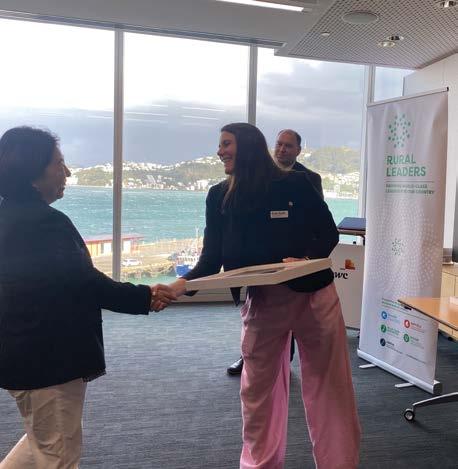
Jiny Kim, TomatoesNZ Board member, recently graduated from the HortNZ Leadership Programme. In the two years since Jiny was elected onto the board, she has grown in voice and knowledge as a grower, a grower representing her local community and as a director overseeing the governance of TomatoesNZ. Well done Jiny – you’ve worked hard and deserve to be recognised!



WIND ADDS TO CHALLENGING SEASON
Despite spring storms and shifting global dynamics, the avocado sector is moving forward with renewed focus and coordinated effort.
NZ Avocado chief executive Brad Siebert says the 2025–26 export season is well underway, with exporters actively targeting key markets across Asia, North America and Australia. While competition from other origins remains strong, the sector is committed to elevating the global profile of New Zealand avocados.
Recent international activity included a united exporter presence at Asia Fruit Logistica in Hong Kong and broader horticulture representation at World Food India in New Delhi. These events provided valuable platforms to promote New Zealand supply, launch the new FernMark certification and engage directly with trade officials and buyers.
While competition from other origins remains strong, the sector is committed to elevating the global profile of New Zealand avocados
Brad says the sector’s presence in India was a deliberate step to support ongoing trade negotiations and position New Zealand’s avocado sector as a trusted partner in growing bilateral relationships.
Market dynamics and export focus
Global supply pressures continue to influence export strategies, with careful volume and timing decisions required across all markets.
While existing Asian markets remain well serviced, new opportunities are emerging in North America. Canada is expected to receive growing volumes, while the 15 percent tariff into the United States, though not ideal, is consistent with seasonal competitors like Peru. Major export destinations this season include Australia, Korea, Hong Kong and China, with steady volumes to Taiwan, Thailand, Japan and Singapore.

Bay of Plenty wind event – official classification confirmed
NZ Avocado can now confirm that the wind event on 13–14 September in the Western Bay of Plenty has been officially classified by the Ministry for Primary Industries (MPI) as a “localised adverse event.”
This classification activates a range of support mechanisms:
• Inland Revenue has been notified, enabling access to existing tax flexibility provisions such as re-estimation of provisional tax, early withdrawals from Income Equalisation Scheme accounts, and late payment/filing relief.
• The Ministry of Social Development will be engaged to ensure affected growers are aware of potential eligibility for Working for Families adjustments, Emergency Benefit or other income-related assistance.
• Regional and local councils will be informed to begin enabling relevant support options.
• The Bay of Plenty Rural Support Trust will continue its role in providing pastoral care, wellbeing referrals, mentoring and community support within existing funding arrangements.
NZ Avocado will remain actively engaged with MPI and other agencies to support growers through this event.
Grower
impact and community response
The wind event caused significant damage to orchards in the region, with some growers losing over 80 percent of their fruit. While the full impact is still being quantified, early estimates suggest export volumes from the Bay of Plenty may be down by more than 500,000 trays.
Beyond fruit loss, tree health is a key concern.
Damage to leaves and emerging flowers will have multi-season implications, and growers are now seeking both financial and on-orchard strategies to maintain productivity.

Alistair Young, chair of the NZ Avocado Growers Association, says the Katikati district was particularly hard hit, with many orchards suffering losses of up to 80 percent. On his own orchard, he estimates a 70 percent loss of fruit destined for export. “We really only had one option and that was to go in and mulch the whole lot, otherwise we’ll have hectares of guacamole to deal with,” he says.
Alistair also notes the longer-term impact on next season’s crop, with many orchards losing flowers alongside the fruit. Despite the severity, he’s been impressed by the resilience of the 100-plus affected growers: “They just get on with sorting out their orchards and deal with the losses”.
Our best chance of success lies in an engaged and informed grower base and supply chain
In response, the NZ Fruitgrowers’ Charitable Trust has offered funding for professional consulting and advice, while the NZ Food Network helped rescue over 51,000kg of windfall fruit, distributing it through 39 food hubs to support thousands of families. HortNZ continues to play a critical role in supporting the sector through the event with strong advocacy and response coordination.
Looking ahead
Brad says the trading environment remains dynamic, with global volumes competing for market share. Around 40 percent of the harvest is consumed domestically, and market development work both offshore and in New Zealand will continue to focus on increasing visibility and consumption of New Zealand avocados.
Direct engagement with supermarkets is underway to support coordinated promotions with a dedicated effort on understanding and exposing where margins sit across the supply chain to improve grower returns.
“The challenge is on this season,” Brad says. “Our best chance of success lies in an engaged and informed grower base and supply chain.”

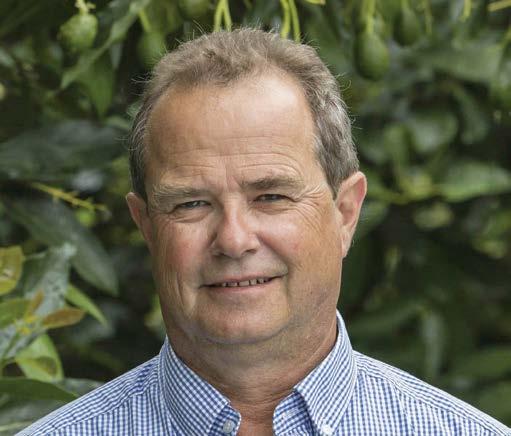

51,000KG AVOCADOS DISTRIBUTED TO 39
DIFFERENT FOOD HUBS IN COMMUNITIES ACROSS THE NORTH ISLAND

Alistair Young, chair of the NZ Avocado Growers Association
NZ Food Network rescue project
TOP QUALITY SEED POTATO
Last month Potatoes New Zealand hosted the annual New Zealand Certified Seed Potato Grower meeting in Methven. I want to acknowledge the vital work of our seed potato growers, who supply the high quality, certified planting material that underpins the entire potato industry while managing significant on-farm challenges.
Kate Trufitt : Potatoes New Zealand chief executive
The meeting offered a forum to share the latest seasonal results and industry updates, to discuss seed challenges, and to hear growers’ questions and priorities for the season ahead. These conversations reinforce how essential reliable certified seed is to production, yield and biosecurity across New Zealand.
The Canterbury Connection
Approximately 95 percent of New Zealand’s seed potato production takes place in the Canterbury region, from where seed is distributed nationwide. This concentration reflects the region’s favourable growing conditions and shifting economic factors over recent decades.
The Canterbury plains topography allows for large flat production sites ideally suited to mechanised seed production; from planting and harvesting, to spraying and irrigating. Canterbury’s climate and temperature with relatively low rainfall during the growing season supports consistent crop development while fertile alluvial soils provide deep, well drained profiles ideal for tuber growth and disease management. The colder South Island winters help to control the pest population between growing seasons.
Certification, history and in‑house improvements
The New Zealand Seed Potato Certification Scheme, established in 1948, provides growers with assurance that seed lines meet strict quality standards. It is managed by the New Zealand Seed Potato Certification Authority, a sub-committee of the Potatoes New Zealand Board that includes representation from seed growers, commercial growers, seed companies and process companies. The scheme is benchmarked to United Nations Economic Commission for Europe (UNECE) seed standards which New Zealand joined in 2014. In 2021 Potatoes New Zealand brought day-to-day management of the scheme in-house. That change has improved traceability, data management and programme efficiency.
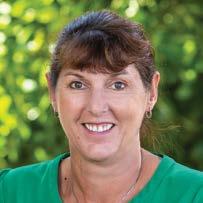
Shortly, seed potato field inspections begin for this season. Potatoes New Zealand’s specialised inspectors visually examine crops in the field, looking for any growth that is irregular, shows symptoms of stress or disease, plants not consistent with variety, and other crop issues. Later in the season tubers are inspected after harvest, checking for signs of disease, maintaining crop hygiene and ensuring seed line segregation.
The Canterbury plains topography allows for large flat production sites ideally suited to mechanised seed production
BELIS, Potatoes New Zealand’s dedicated database, was developed to improve the recording of seed potato certification activities and the traceability of seed lines. This move has been successful, ensuring close communication and focus on continuously improving and streamlining the scheme, whilst supporting industry to remain world-leading in quality and yields.
Rising to modern challenges
One significant challenge is staying on top of the nuances of an increasing number of potato varieties available in New Zealand. Many new potato varieties are imported from around the world. Evaluating variety performance for New Zealand’s climate and markets is often a slow, trial-based process that can take many years. This work is carried out by seed merchants and carries a heavy risk as a low percentage of varieties are taken through to commercial growers.
Risk management of pests and disease, including bacteria, fungi and viruses in seed potatoes remains another major challenge because seed-borne infections can reduce tuber quality and yields.
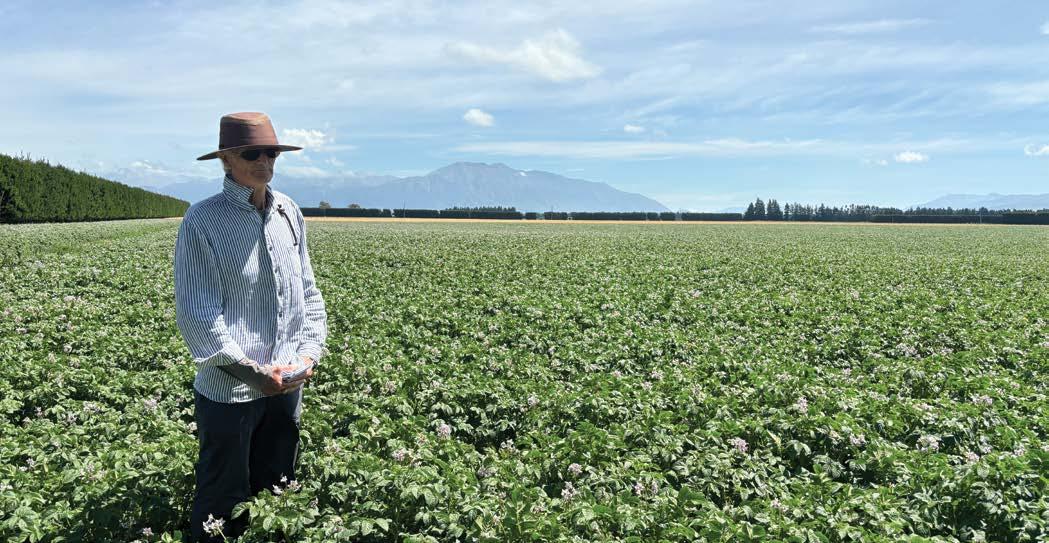
The scheme’s protocols respond to these risks: Generation 2 lines undergo mandatory leaf virus testing, every seed generation receives at least two crop inspections for viruses, varietal purity and other defects, and tuber inspections occur whenever seed line ownership changes. Seed potato growing relies heavily on clean land to ensure seed lines are not impacted by soil-borne pests and disease such as Potato Cyst Nemotode. Access to both land and water continues to be a challenge and cost for growers.
I’m proud of the daily work our seed potato industry does to maintain these exceptional standards
The industry led and managed certification scheme demonstrates the collaboration between seed merchants, seed potato growers, and fresh and process growers. Together we recognise the value of managing these risks for our world-leading potato industry. Bringing the management of the Seed Potato Scheme in-house at Potatoes New Zealand has strengthened our ability to protect the industry and give potato growers confidence in the quality of their purchased seed potatoes.
I’m proud of the daily work our seed potato industry does to maintain these exceptional standards.
If you have any questions, please contact Potatoes New Zealand.
Phone: 0800 399 674
Email: info@potatoesnz.co.nz
Website: www.potatoesnz.co.nz
95% OF NEW ZEALAND’S SEED POTATO PRODUCTION TAKES PLACE IN THE CANTERBURY REGION
Cyril Hickman, seed certification manager at Potatoes New Zealand, in a paddock of seed potatoes
IMPROVE FRUIT QUALITY AND HARVEST FLEXIBILITY
As every busy pipfruit grower knows, planning harvest logistics for best fruit quality across blocks and varieties can be challenging.
A plant growth regulator like Harvista™ 1.3SC, from AgroFresh, offers orchardists the opportunity to slow down the ripening process, allowing apples and pears to remain on the tree longer without compromising quality.
Applied near harvest, the active ingredient of Harvista 1.3SC, 1-methylcyclopropene (1-MCP), blocks the perception of the ethylene by the fruit, and delays fruit ripening and drop.
Matt Punter, AgroFresh technical account manager for New Zealand, explains, “Unlike other plant growth regulators that block ethylene production, Harvista works by binding to ethylene receptors in the fruit, rendering them unresponsive to ethylene. This real-time regulation of ethylene response enables growers to delay harvest by up to 14 days, providing greater flexibility in managing labour and weather-related challenges. Growers can target specific blocks and varieties for more strategic storage options. Harvista also helps maintain fruit firmness, colour and size, characteristics which are critical for marketability and storage performance.”
Tristram Hoddy from Vailima Orchard in Hope, Nelson, says he found Harvista very effective and easy to use. “Given our range of varieties, Harvista allows us to spread the harvest and delay maturity so that we even up maturity and improve colour,” says Tristram. “In practice, we are picking more fruit in the first pick, a benefit in terms of returns. And with the fruit on the tree longer, we also get the side gain of increased product size and yield.”
Best use guidelines
• Harvista application timing is four to 21 days before the ‘normal’ harvest date, i.e. the estimated harvest date if no Harvista were applied.
• Earlier applications provide a more consistent result.
• Harvista can also be applied after the first pick to provide flexibility with picking dates with the remaining crop.
• Starch testing of the fruit provides the best method of verifying appropriate application timing. Begin testing approximately two weeks before expected application and repeat every five to seven days.
• Application timing may also be determined by historical harvest dates adjusted by the relative earliness of the current season.
• Harvista application is simple to set up, however it differs from typical orchard sprays and requires a different approach. Understanding application equipment is critical for a positive result.
• Do not mix with copper-based compounds.
• Harvista has a four-day pre-harvest interval (PHI) for apples in New Zealand.
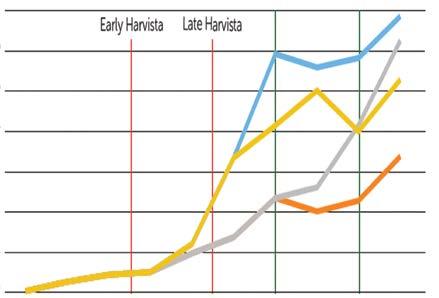
Untreated Double (18+4 DBH)
Early (18 DBH) Late (4 DBH)
DBH = Days Before Harvest
Source: New Zealand
• The early application of Harvista delayed maturity development in Gala for approximately 20 days. After this the effect of Harvista began to wear off and starch degradation continued more rapidly.
• The late application of Harvista was still very effective at arresting the progress of maturation despite the fact that the fruit maturity was more advanced at the time of application.
• As demonstrated in this orchard, a second application over already treated fruit can provide unparalleled extension of harvest maturity.
For multiple pick varieties, such as Gala, an early application of Harvista will give a more consistent result as the maturity on the tree is more even at the time of application.
Enquiries – Please contact Chris Waites: M: 027 233 6949 E: cwaites@agrofresh.com

Starch in Gala
Early Harvista Late Harvista

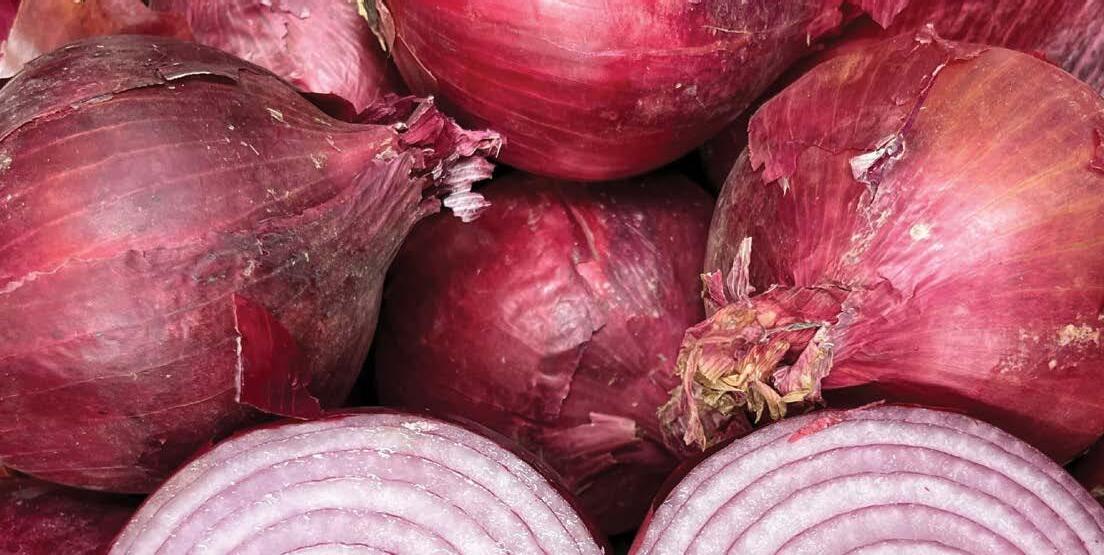
BIOSECURITY ALERT
Biosecurity New Zealand is urging people in Auckland to be on the lookout for yellow-legged hornets (Vespa velutina) following the first discovery of a queen yellow-legged hornet in the early stages of building a nest in the suburb of Glenfield.
The yellow-legged hornet is a biosecurity concern due to its potential impact on honeybee and wild bee populations.
It is a highly adaptable predator with a broad diet, primarily feeding on bees, wasps and flies, but also ripe fruit and flower nectar, posing a risk to growers. It may compete with native insects and birds for food, and it has a painful sting.
Report any sightings of suspected hornets or hornet nests online at report.mpi.govt.nz or by calling Biosecurity New Zealand’s exotic pest and disease hotline on 0800 80 99 66.
GROWER INPUT FOR EPA REASSESSMENTS
The Environmental Protection Authority (EPA) is consulting on the use of alachlor and acetochlor (active ingredients in selective pre-emergence herbicides) in New Zealand to inform reassessments of these active ingredients due to risks to humans and the environment.
HortNZ is coordinating a submission to the consultation which will outline who uses alachlor and acetochlor products and how. Consultation closes on 19 December 2025. If you are using any alachlor or acetochlor agrichemical products and can provide information about how you use them, please contact Natalie Wong, HortNZ senior risk policy advisor (natalie.wong@hortnz.co.nz).
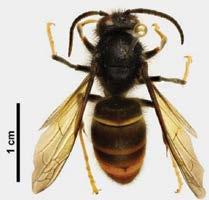

the Auckland region this year. Photo courtesy Biosecurity New Zealand Plant Health and Environment Laboratory
SIGN UP
Get the latest horticulture policy and risk updates, industry programmes and events in your inbox and have your say with HortNZ’s Weekly Briefing. Email comms@hortnz.co.nz to receive the weekly email.
Enza Zaden invites you to join us at
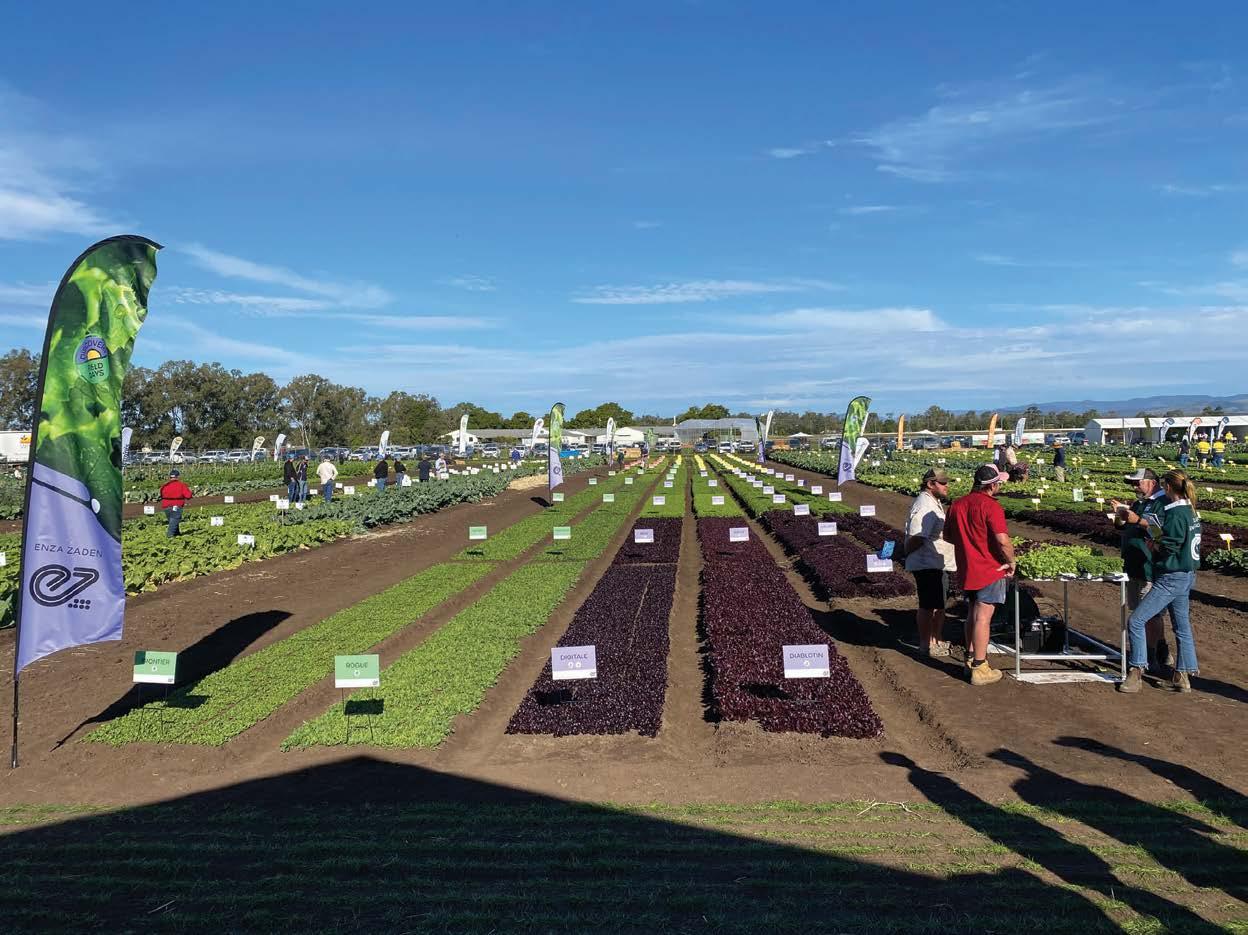
7 - 8 May 2026
Enza Zaden will have on display a broad range of our Leafy Portfolio including:
• Iceberg
• Cos/Romaine (Large, Processing, Mini and Little Gem)
• Babyleaf Lettuce (direct sown)
• Eazyleaf
• Spinach
• Rocket/Rucola
• Hydroponic/CEA/Diverse range
Join us and experience two days of:
• Leading Genetics
• Expert technical knowledge and advice on hand
• Wide industry engagement
• Horticultural, chemical, agronomic and technological displays from industry
Contact your local Enza Zaden Representative for more information or to discuss your participation.
Email: sales@enzazaden.co.nz
Phone: +64 9 963 0122
